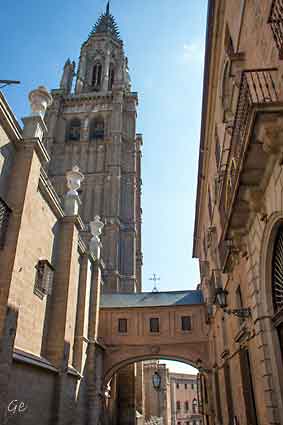| Lørdag
5. mars 2016 Avreise fra Slemmestad ved 9-tida. Flyet (Norwegian) skulle gå kl 13 10. I Malaga bodde vi på Hotel Don Curro. Hotellet hadde fin beliggenhet midt i sentrum, men likevel forholdsvis rolig. Været: Det var litt kjølig, men bra vær da vi kom. På kvelden regna det litt. |
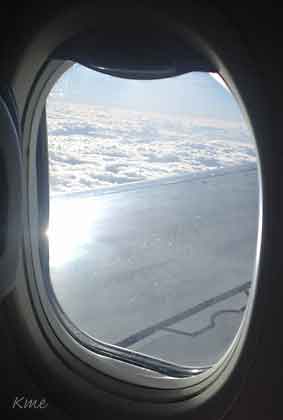 |
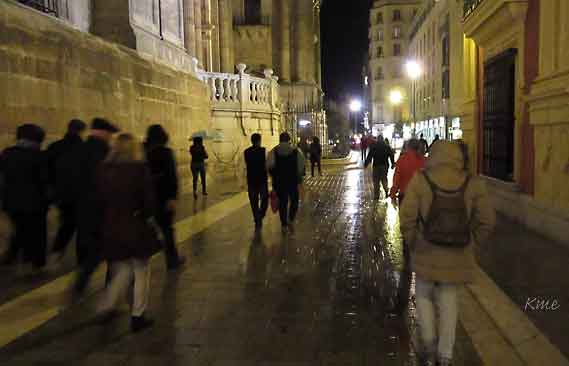
Malaga en sen kveld i regn. Det var lørdagskveld og mye folk på byen.
| Søndag
6. mars 2016 Etter en god frokost gikk vi ut for å se på byen. Vi var først en tur innom Katedralen. Det var søndag formiddag, og derfor messe i katedralen. Vi ville ikke forstyrre, så vi var ikke lenge der inne. I stedet gikk vi opp til Gibralfaro som er det opprinnelige slottet/borgen i Malaga. Været: fint vær, men litt kald vind. temp 14-16 grader |
 Det var streik blant søppelkjørerne og alle byens søppelkasser fløyt over av søppel. 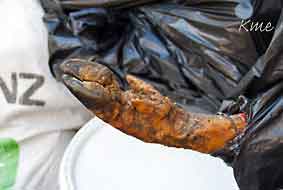 |
| Malaga´s
cathedral was built between 1528 and 1782 on or near the site of a former mosque. While original plans had allowed for two towers, both lack of funds those donated to American Independence resulted in the completion of only one, giving rise to the name by which the cathedral is affectionately referred to, La Manquita, loosely interpreted as "one armed woman". The interior has influences of the Renaissance and baroquestyles. The notable 17th century choir stalls of mahogany and cedarwood were designed by Luis Ortiz. http://www.andalucia.com/cities/ malaga/cathedral.htm |
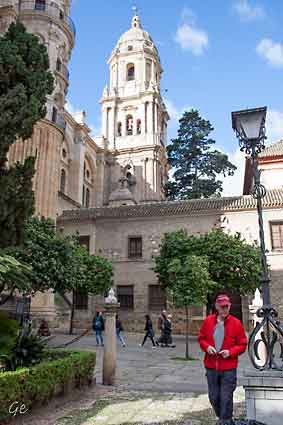 Karl Martin utenfor Katedralen |
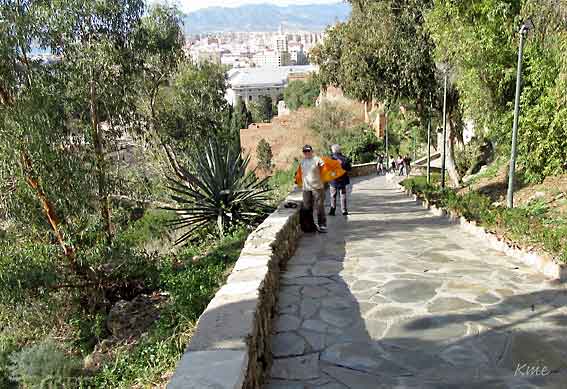
Selv om det ikke var mer enn omkring 15 grader, ble det varmt i
bakken opp til Gibralfaro.
Gibralfaro
Mount Gibralfaro, Spanish: Monte Gibralfaro, is a hill located in Málaga in southeast Spain. It is a 130 m high foothill of the Montes de Málaga, part of the Cordillera Penibética.
| At the top of the hill stands
the Castle of Gibralfaro
overlooking Málaga city and
the Mediterranean Sea, and connected by a
walled corridor to the Alcazaba of
Málaga. Gibralfaro has been the site of fortifications since the Phoenician foundation of Málaga city, circa 770 BC.The location was fortified by Caliph Abd-al-Rahman III in 929 CE. At the beginning of the 14th century, Yusuf I of the Kingdom of Granada expanded the fortifications within the Phoenician lighthouse enclosure and erected a double wall to the Alcazaba. The name is said to be derived from Arabic, Jbel, rock or mount, and Greek the word for light, Jbel-Faro, meaning "Rock of Light". The castle is famous for its three-month siege in 1487 by the Catholic monarchs, King Ferdinand and Queen Isabella, which ended when hunger forced the Arabs to surrender. Gibralfaro - Wikipedia 19. desember 2022 |
 Veien opp til Gibralfaro så ut til å være en vanlig trimtur. Noen løp opp, noen syklet og noen hadde nok med å gå oppover. ______________________________________ |

Utsikt over Malaga fra et utsiktspunkt på veien opp. Bak høyhusa ligger
Malagueta-stranda.
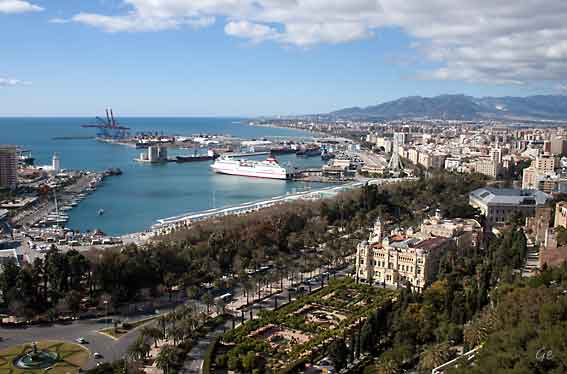
Bortenfor stranda er havna. Den store båten er ei ferga over til Afrika.
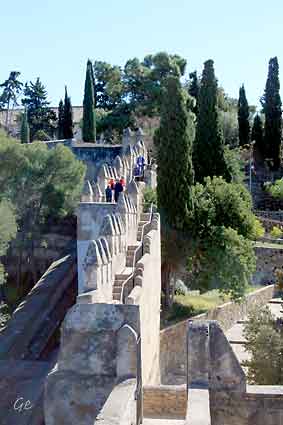 |
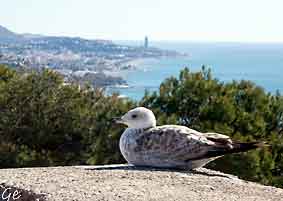 The Castle of Gibralfaro is situated on the mountain with the same name. On top of this mountain there are the remains of a small fortification dating back to Phoenician-Punic times. During the reign of Abderraman III, the Muslims also built a defence on the mountain. The castle we can see nowadays was mostly built by Yusuf I in 1340 AD in order to improve the defence of Málaga. Discover the Gibralfaro Castle - Alcazaba of Malaga (alcazabamalaga.com) (13. oktober 2023 ) |
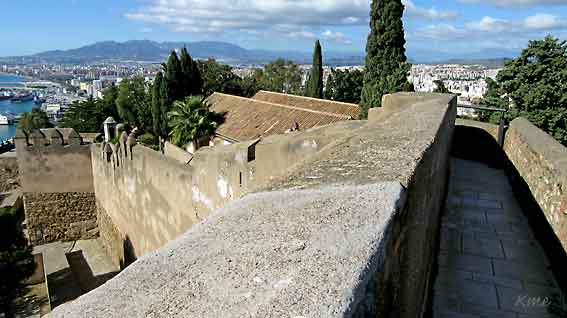
The upper part is called the main courtyard and houses the Interpretation Centre
where you can discover the history of the castle through the lives of its inhabitants.
You will find the Main Tower (Torre Mayor), 17 metres high, the Phoenician
well and the baths in this section. The Airón well was dug in solid rock to a
depth of 40 meters.
(19. desember 2022) 15 Tourist hotspots in Málaga that live up to the hype (msn.com)
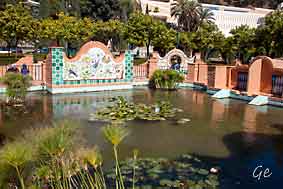 |
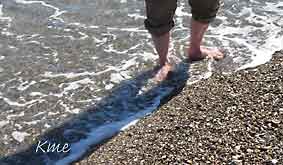 |
Så gikk vi videre til stranda. Vi hadde ikke med badetøy, så noe bad ble det ikke.
LA MALAGUETA
This is a very large man made beach, it is accessed via the Pablo Picasso promenade whose bars and restaurants are busy day and night. It has aview of the fishing area where you can see the fisherman untangling their
nets.
http://www.andalucia.com/cities/malaga/beaches.htm
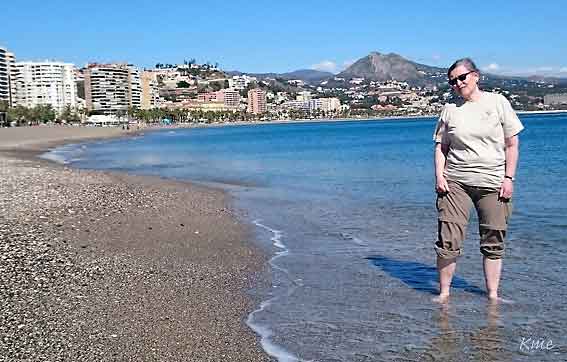
Grete tester badetemperaturen.
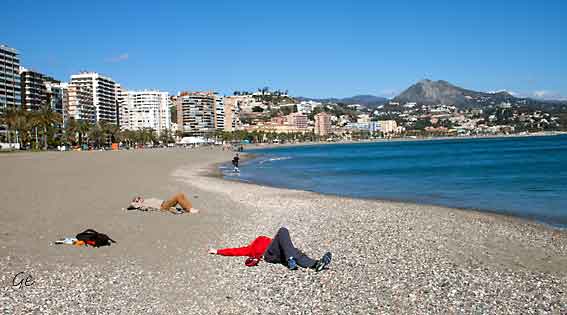
Karl Martin slapper av i den varme sanda.
There are a number of Chiringuitos offering a selection of drinks and Tapas.
Facilities include: disabled access, warning advice, hire of sunbeds and
parasols, parking, public telephone, showers, W.C and a children´s play area.
This beach is the closest to the city centre located to the east of the port.
http://www.andalucia.com/cities/malaga/beaches.htm

Det var ikke den store dagen for dem som leier ut solsenger.
Været var fint, men vinden var litt for kald.
ighthouses. There is a small information board by the side of it, which I shall
quote verbatim -
completed in 1817, being located at that time at the entrance to Malaga Port.
It stands 38 meters above the sea and its light theoretically reaches as far as
25 miles, with 3 + 1 flashes every twenty seconds.
http://lighthousesabroad.blogspot.no/2014/05/la-farola-malaga.html?view=classic
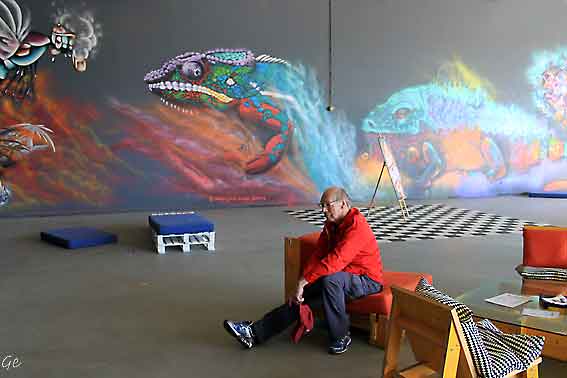
På veien fra stranda og tilbake til sentrum kom vi forbi en kunstutstilling.
Kunstneren er Andres Serna.
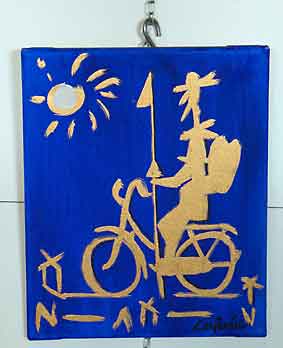 Don Quijote var også på utstillingen. Kunstneren var Curro Leyton. |
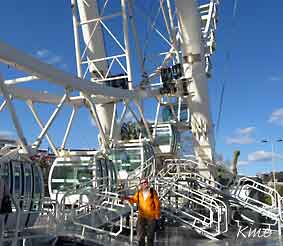 Pariserhjulet i Malaga |
in Malaga port, near the city centre. Billed as Europe's largest itinerant ferris
wheel, it opened in September 2015 and will be in situ until September 2016, or
possibly longer if the contract is extended again.
http://www.andalucia.com/cities/malaga/big-wheel-noria.htm
Vi begynte dagen med å hente billettene til Alhambra i Granada.
Dit skulle vi neste dag.
Vi var også innom turistinformasjonen for å få rutetabeller til buss og tog.
Det var flere byer i nærheten vi skulle besøke i løpet av ferien.
Været: opp til 13 grader, vind opp til 8 m/s.
En kort, men kraftig regnskur om formiddagen og en om kvelden.
Vi hadde tenkt å begynne dagenmed et besøk i Carmen-Thyssen museet.
Men museer har ofte stengt mandager, og sånn var det her også.
| Like
ved Carmen-Thyssen ligger kirken Santo Cristo. Vi var innom den. 16th Century. Known as the Santo Cristo (Holy Christ), this church was founded by the Jesuits, who also gave their name to this street (Calle de la Compañía). It is the first building on the right at the entrance of Calle de la Compañía and it is unusual in that it has a circular floor plan. In 1572, after the Jesuits came to do missionary work in Málaga, the Jesuits decided to settle here and purchased a house next to the San Sebastian Sanctuary where they practised their ministry. They decided to build a new church because the Sanctuary was not large enough to hold public services. The works were not started until 1598 and the church opened on 28 September 1630 although some work continued until 1644. Santo Cristo de la Salud Church - Monuments - Visita Málaga (malaga.eu) (19. desember 2022) |
 |
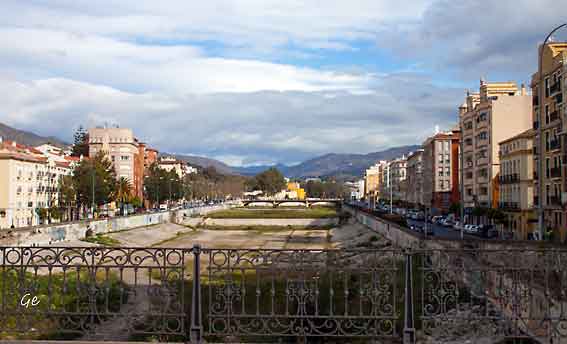
The Guadalmedina (from the Arabic wādi, “river” + medina, "city";
River of the City) is a river that runs through the city of Málaga, Spain.
Historically, it has played an important role in the city's history, and has
divided the city into two halves. The city’s historic center is located on its
left bank.
It is a river subject to high seasonal variations and has five well defined
tributaries which have their sources in the Montes de Málaga range, the
Arroyo de las Vacas, Arroyo Chaperas, Arroyo Humaina, Arroyo Hondo and
Arroyo de Los Frailes. All of these rivers are dry most of the year.
Located in the mountains, the Limonero Dam on the Guadalmedina
provides water for the area.
https://en.wikipedia.org/wiki/Guadalmedina
| The
word Alcazaba comes from
Arabic ‘AL-qasbah’ and refers to a
fortification within a walled town. It is a fortified palace, and differentiates itself from a castle by the fact that it does not have a medina inside. Inside the Alcazaba,
there used to be the residential area and
palace of the governor. Additionally, the
Muslim fortress also housed silos and cisterns
to allow the troops and population of Málaga
to survive in case of an attack. It is considered as one of the most beautiful Alcazabas that you can visit in Spain. It was built on the slopes of the Gibralfaro mountain where there were already some Phoenician-Punic remains. This position was a very strategic defence point of the city. Today, the Alcazaba of Málaga has an area of 15.000 square metres, but during the Islamic period, it was without a doubt much bigger. Part of the walls and the Haza Baja has been lost since then. |
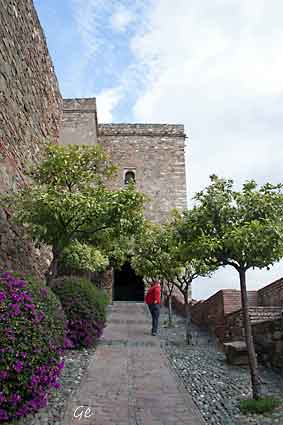 The Alcazaba was constructed by the Muslims during their occupation of the Iberian Peninsula during the Middle Ages. However, categorising it as a medieval fortress won’t do it justice. Because of its unique historical and topographical evolution, you can say that the Alcazaba of Málaga really had a life of its own. Home - Alcazaba of Malaga (alcazabamalaga.com) (19. desember 2022) |
Det var ikke mye vann der nå.
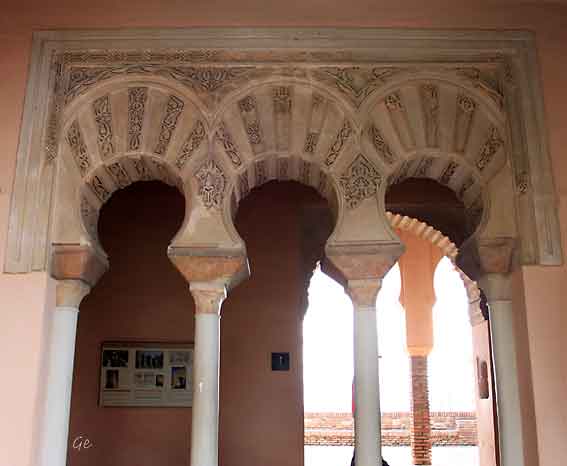
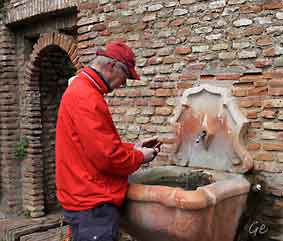 Karl Martin fotograferer på Alcazaba |
 Keramikkovn på Alcazaba |
 Karl Martin slapper av på Alcazaba. |
 Grete utenfor Picassomuseet. |
Pablo Picasso is probably the most important figure of 20th century, in terms of art, and art movements that occurred over this period. Before the age of 50, the Spanish born artist had become the most well known name in modern art, with the most distinct style and eye for artistic creation. There had been no other artists, prior to Picasso, who had such an impact on the art world, or had a mass following of fans and critics alike, as he did.
Pablo Picasso was born in Spain in 1881, and was raised there before going on to spend most of his adult life working as an artist in France. Throughout the long course of his career, he created more than 20,000 paintings, drawings, sculptures, ceramics and other items such as costumes and theater sets.
He is universally renowned as one of the most influential and celebrated
artists of the twentieth century.
http://www.pablopicasso.org/
| The Museo
Picasso Málaga is a museum
in Málaga, Andalusia, Spain, the
city where artist Pablo Ruiz
Picasso was born. It opened in 2003 in the Buenavista Palace, and has 285 works donated by members of Picasso's family. In 2009, the Fundación Paul, Christine y Bernard Ruiz-Picasso that owned the collection merged with the Fundación Museo Picasso Málaga that operated the museum, which is based in the home on Málaga's Plaza de la Merced that was Picasso's birthplace, and is now the Museo Casa Natal ("Birthplace Museum"). The new merged foundation is the "Fundación Museo Picasso Málaga. Legado Paul, Christine y Bernard Ruiz-Picasso" ("Museo Picasso Málaga Foundation. The Paul, Christine and Bernard Ruiz Picasso Legacy") Museo Picasso Málaga - Wikipedia (19. desember 2022) |
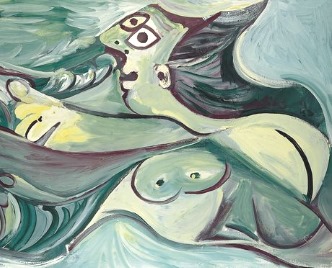 Bather The limbs of the undulating bather in this late work by Picasso are barely distinguishable from the foamy green sea surging around her. Bilde fra http://www.museopicassomalaga.org/en |
Tirsdag den 8. var avsatt til en tur til Alhambra i Granada.
Billettene var kjøpt inn på internett. Det var begrensa hvor mange
som slapp inn hver dag. Det gjaldt særlig Palacios Nazaries,
eller Nasridpalasset.
Bussen til Granada tok litt over to timer, men det var interessant
å se innlandet også,
små hvite byer, olivenskoger etc.
Fra bussterminalen tok vi taxi opp
til Alhambra. Alternativet var tre forskjellige busser.
Det er ikke så enkelt med flere
bussbytter når man er helt ukjent på stedet.
Vi hadde billetter til kl 14. Klokka 12 30 var vi framme. Så vi rakk både å
spise lunsj og å se oss litt om i området før vi slapp inn på Alhambra.
Heldigvis var været fint, selv om det fortsatt var litt kald vind.
Det lå nysnø i fjellene rundt byen.
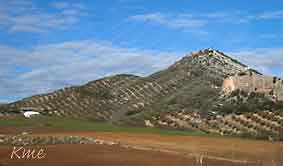 Oliventrær sett fra bussen |
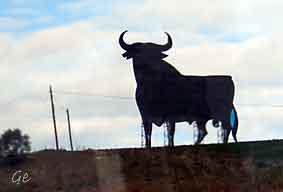 El Toro |
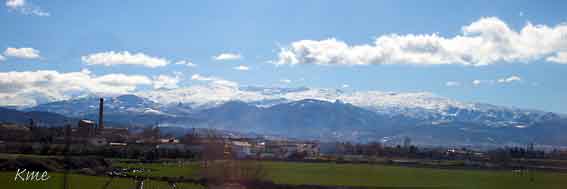
Sierra Nevada fra Granada
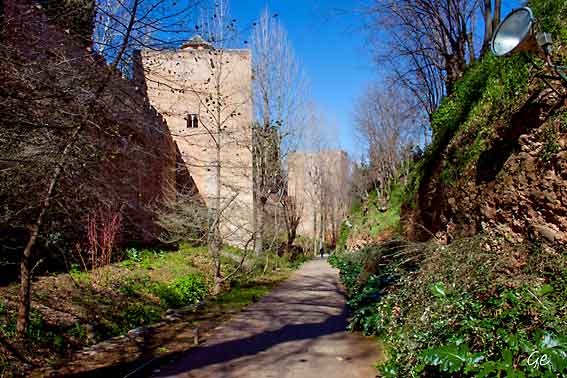
Vi slapp ikke inn på Alhambra før klokka 1400,
men litt kunne vi se selv utenfor murene.
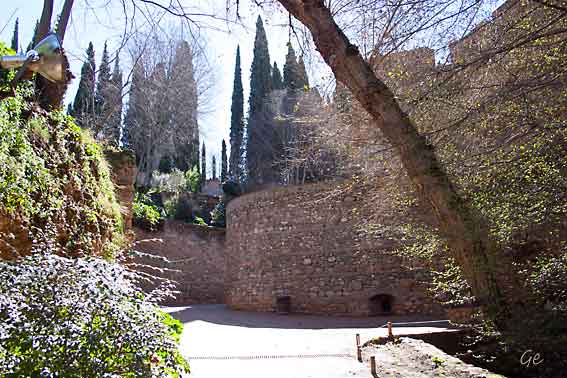
Alhambra utenfor murene
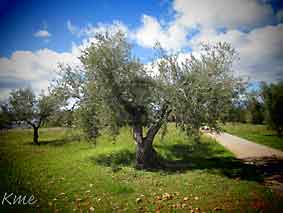 |
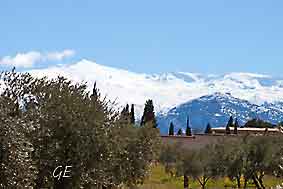 |
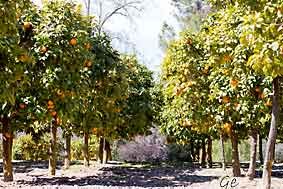 Appelsintrær i Granada |
 |
"red or crimson castle", perhaps due to the hue of the towers and walls that
surround the entire hill of La Sabica which by starlight is silver but by
sunlight is transformed into gold. But there is another more poetic version,
evoked by the Moslem analysts who speak of the construction of the Alhambra
fortress "by the light of torches", the reflections of which gave the walls their
particular coloration. Created originally for military purposes, the Alhambra
was an "alcazaba" (fortress), an "alcázar" (palace) and a small "medina" (city),
all in one. This triple character helps to explain many distinctive features of the
monument.
There is no reference to the Alhambra as being a residence of kings until the
13th century, even though the fortress had existed since the 9th century. The
first kings of Granada, the Zirites, had their castles and palaces on the hill of
the Albaicin, and nothing remains of them. The Nasrites were probably the
emirs who built the Alhambra, starting in 1238.
The founder of the dynasty, Muhammed Al-Ahmar, began with the restoration
of the old fortress. His work was completed by his son Muhammed II, whose immediate successors continued with the repairs. The construction of the
palaces (called Casa Real Vieja, "old Royal House or Palace") dates back to the
14th century and is the work of two great kings: Yusuf I and Muhammed V.
To the first we owe, among others, the "Cuarto de Comares" (Chamber of
Comares), the "Puerta de la Justicia" (Gate of Justice), the Baths and some
towers. His son, Muhammed V, completed the beautification of the palaces
with the "Cuarto de los Leones" (Chamber of the Lions), as well as other
rooms and fortifications.
http://www.andalucia.com/cities/granada/alhamhistory.htm
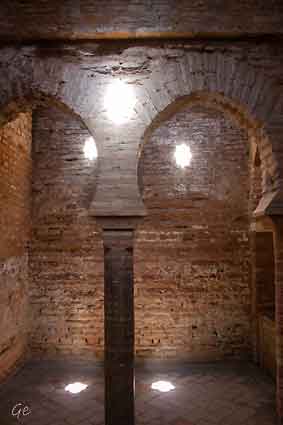 The Mosque Baths of the Alhambra |
 |
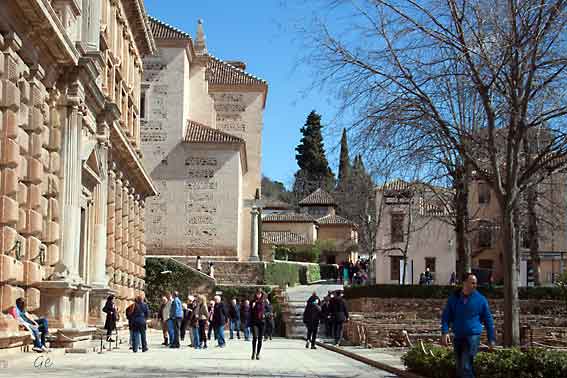
Til venstre: Carlos V Palace
The emperor ordered the construction of the palace next to the Alhambra to enjoy its wonders. The architect in charge of the work was Pedro Machuca, a lover of the rebirth of proven experience. The construction of the palace began in 1527 and financed in its entirety in 1957.

Carlos V Palace
The construction went through several stages, lack of funds, uprisings that
stopped the works, and so on. The roofs sank by default.
Palace of Carlos V - Alhambra of Granada (13. oktober 2023)
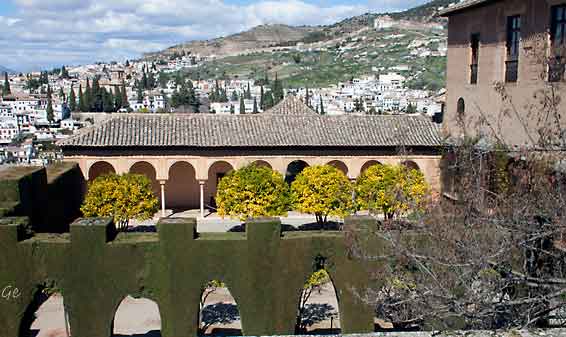
| The
Nasrid Palaces Mohammed ben Al-Hamar (Mohammed I) was the first king to move to the Alcazaba and no records about a new palace being built are kept until those of Abu l-Walid Ismail (fifth king of the dynasty). A palace was built near the Great Mosque (Gran Mezquita) but only the Mexuar is now left because Yusuf I destroyed it completely. He started some improvements in the Comares Tower (Torre de Comares), the Court of the Myrtles (Patio de los Arrayanes) and the Baths (Baños). |
 These improvements were finished by Mohammed V, who added them all to the Mexuar, extended the gallery that would later be called Machuca and constructed the Palace of the Lions (Palacio de los Leones). |
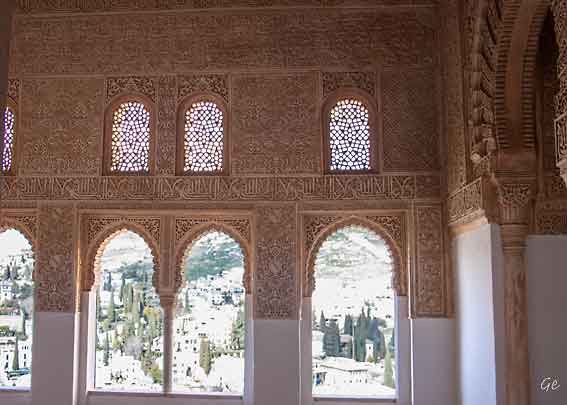
Til høyre (to the right):
The Court of the Myrtles (Patio de los Arrayanes) has received different names
throughout time. Its current name is due to the myrtle bushes that surround
the central pond and the bright green colour of which contrasts with the
white marble of the patio. It was also called the Patio of the Pond or the
Reservoir (Patio del Estanque o de la Alberca) because of the central pond,
which is 34 metres long and 7,10 meters wide.
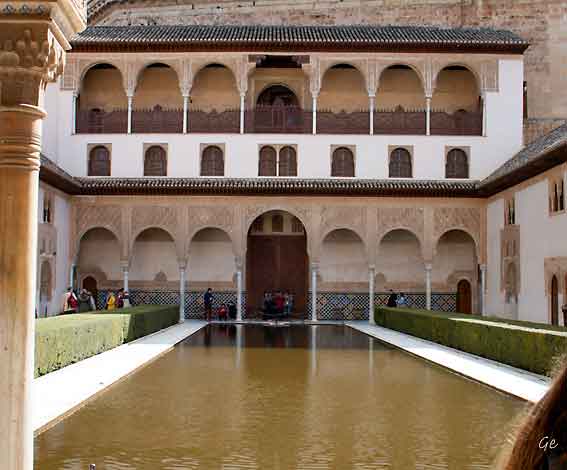
The pond divides the patio and receives its water from two fountains (one at
each end of the pond). There are chambers on both sides of the patio and
several porticoes on the shorter sides of it. These porticoes rest on columns
with cubic capitals, which have seven semicircular arches decorated with
fretwork rhombuses and inscriptions praising God.
The central arch is greater than the other six and has solid scallops decorated
with stylised vegetal forms and capitals of mocarabes.
http://www.alhambradegranada.org/en/info/placesandspots/courtofthemyrtles.asp
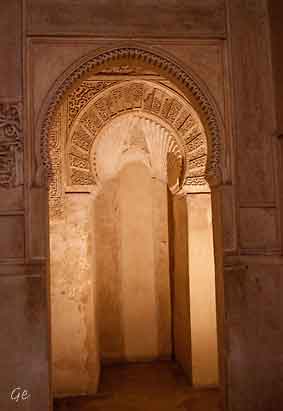 |
Til
høyre (to the right): Palace of the Lions When Mohammed V succeeded his fatherYusuf I, he did more than just finishing the alterations that his father had started. He actually started building what would become his great work of art, the marvellous legacy he left us in the Alhambra: the Palace of the Lions (Palacio de los Leones). This palace comprised the private chambers of the royal family and it was built in the angle formed by the Baths (Baños) and the Court of the Myrtles(Patio de los Arrayanes). |

Palace of the Lions
http://www.alhambradegranada.org/en/info/placesandspots/halloftheabencerrajes.asp
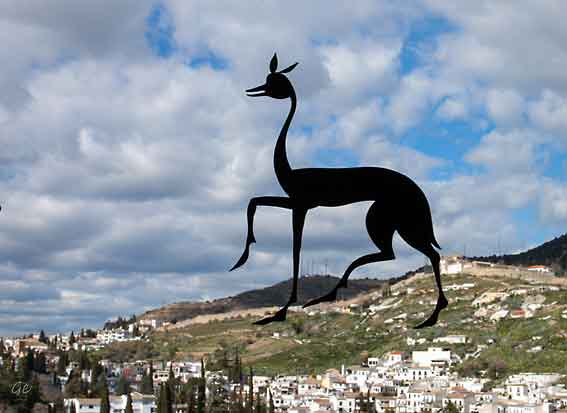
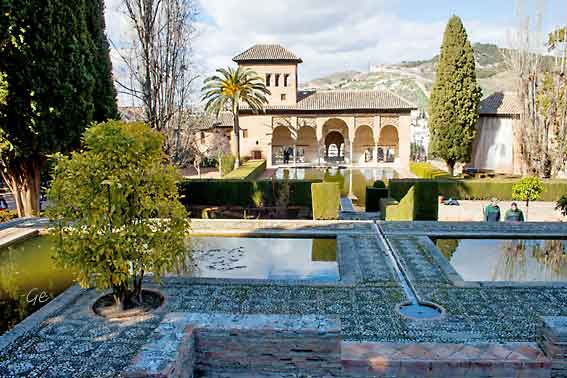
The Nasrid Palaca
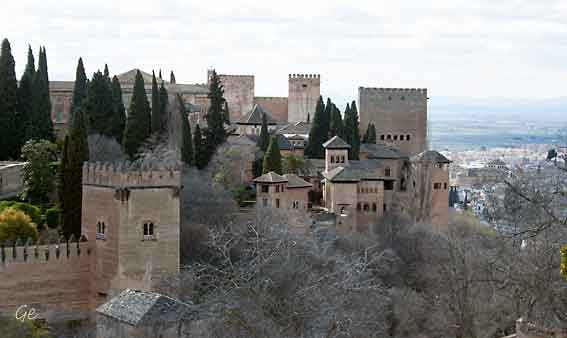
Alhambra fra Generalife

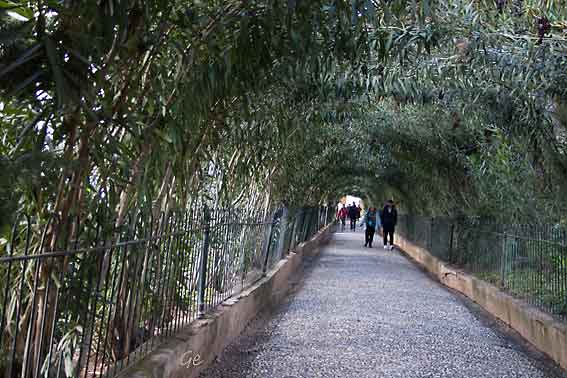
It occupied the slopes of the Hill of the Sun (Cerro del Sol), from which there
is a complete view over the city and the valleys of the rivers Genil and Darro.
There are different interpretations of the meaning of its name: the Governor's Garden, the Architect's (alarife) Garden, the Vegetable Garden of the Gypsy
Festivity Organiser, etc. The Generalife became a leisure place for the kings of Granada when they wanted to get away from the official affairs of the palace.
Abu I-Walid Isma'il (1313-1324), as it is explained by an inscription
that dates from 1319. This means that the Generalife was built before
the Comares Palace. In spite of it being very close to the Alhambra
and the close relationship between the two complexes, it is considered
to be outside the city. A rebellion against Mohammed V even broke
out in the Alhambra while he was in the Generalife.
https://www.alhambradegranada.org/en/info/generalife/thegeneralife.asp

Alcazaba
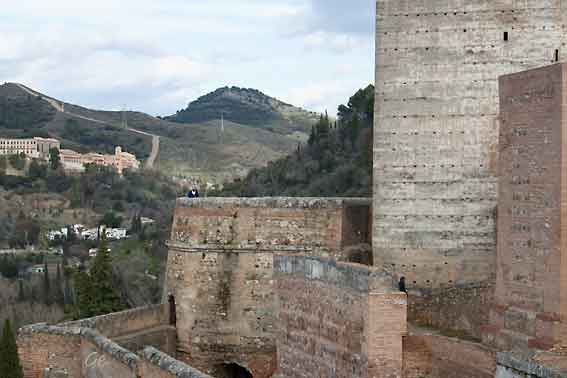
Alcazaba
The Alcazaba, a fortress, is one of the oldest part of the Alhambra, as is the
case of the Vermilion Towers (Torres Bermejas). It is thought that before it
was built and before the Muslims arrived to Granada, there were already
several constructions in the same area. The first historical reference to the
existence of the Alcazaba dates from the 9th century and it is believed that
it was then built by Sawwar ben Hamdun during the fights between
Muslims and muwalladins [Christians who converted to the Islam and
lived among the Muslims].
The current complex was built by Mohammed I, who constructed the
ramparts around the previous castle, defences and three new towers:
The Broken Tower (Torre Quebrada), the Keep (Torre del Homenaje)
and the Watch Tower (Torre de la Vela). As a consequence, the Alcazaba
became a real fortress, where the king established the royal residence.
His son Mohammed II also had his residence in the Alcazaba, until the
palaces were finished. From then on, the Alcazaba was only used as a
fortress for military purposes.
https://www.alhambradegranada.org/en/info/alcazaba/alcazaba.asp
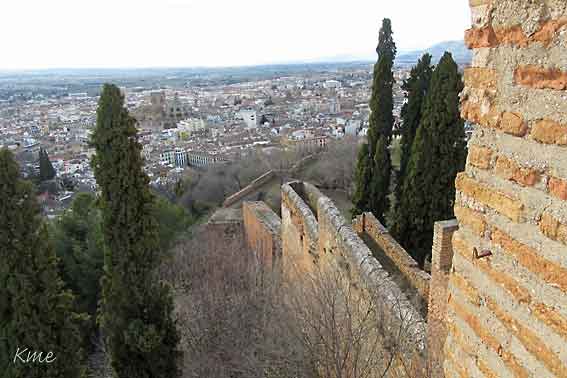
Alcazaba
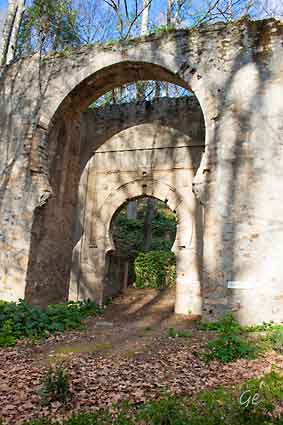 The gate was located in the stretch of wall of the medina of Granada until the last quarter of the 19th century, and between 1873 and 1884 the process of demolition began. It gave access to the square of the same name which was the centre point of Nasrid Granada which s pread around it. It was mainly mud built, with certain formal and structural elements made of stone. |
This
is popularly known as the gate of Bibrrambla, Bab al-Ramla in Arabic or gate of Arenal, (sand) names that it adopted according to the place where it was originally located. Another name is also Arch of the Ears (Arco de las Orejas), a supposed name, because malefactors executed by law were exhibited under it. http://www.alhambra-patronato.es/ index.php/Puerta-de- Bibarrambla/1620+M5d637b1e38d/0/ (2016) 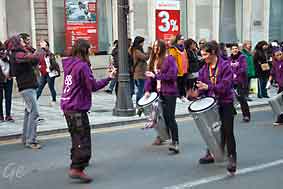 8. mars demonstrasjon i Granada International Women's Day (March 8) is a global day celebrating the social, economic, cultural and political achievements of women. The day also marks a call to action for accelerating gender parity. https://www.internationalwomensday.com/About |
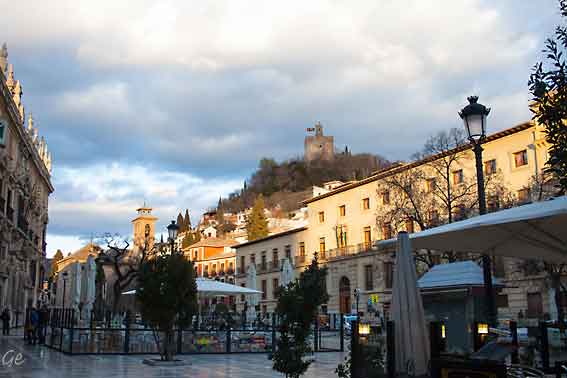
Fra sentrum av Granada ser vi opp mot Alhambra
Granada was first settled by native tribes in the prehistoric period, and was
known as Ilbyr. When the Romans colonised southern Spain, they built their
own city here and called it Illibris. The Arabs, invading the peninsula in the
8th century, gave it its current name of Granada. It was the last Muslim city
to fall to the Christians in 1492, at the hands of Queen Isabel of Castile and
her husband Ferdinand of Aragon.
One of the most brilliant jewels of universal architecture is the Alhambra,
a series of palaces and gardens built under the Nazari Dynasty in the 14th C.
This mighty compound of buildings – including the summer palace called
Generalife, with its fountains and gardens - stands at the foot of Spain's
highest mountain range, the Sierra Nevada, and overlooks the city below
and the fertile plain of Granada.
http://www.andalucia.com/cities/granada.htm
Været: Opp til 18 grader, fortsatt litt kald vind, for det meste sol.
Dagen startet med et besøk i Carmen-Thyssen museet.
Ellers hadde vi en rolig dag.
Mye av dagen var vi på stranda
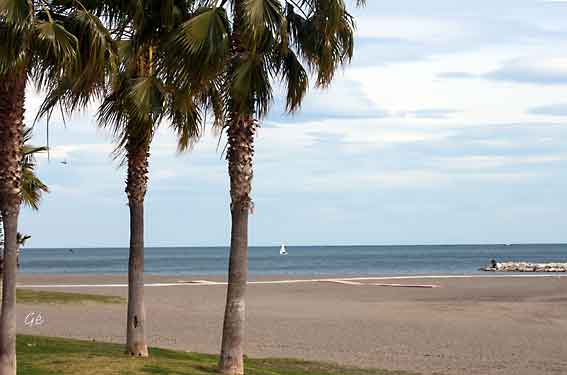
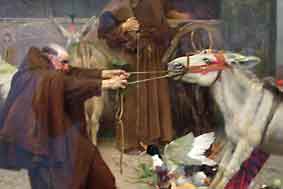 |
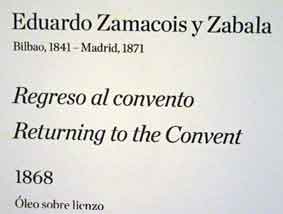 |
Eduardo Zamacois y Zabala (2 July 1841 – 12 January 1871)[1][2] was a Spanish
academic painter who was born in Bilbao, Spain on 2 July 1841. He moved to
Madrid in 1859, where he enrolled in the Real Academia de Bellas Artes de San
Fernando and studied with Federico de Madrazo.
In 1860, he studied in Paris with Jean-Louis-Ernest Meissonier (1815–1891).
He achieved success at the Paris Salon of 1867 with Buffon au 16e siècle.
On 18 November 1865 in Paris, he married Marie Louise Perrin. They had two
children, born in Louveciennes: a boy named Miguel (1866) and a girl named
Maria Helena (1871), who married the French painter Jean Alfred Marioton.
Zamacois y Zabala is associated with both classicism and anti-clerical art. He is
known to have employed the Swiss painter Edouard Castres (1838–1902) as
his assistant. He died in Madrid in 1871 at the age of 29.
https://en.wikipedia.org/wiki/Eduardo_Zamacois_y_Zabala
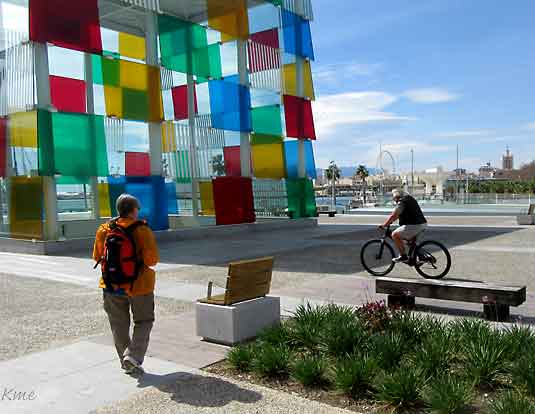
THE POMPIDOU CENTRE MALAGA
The Pompidou Centreby Fiona Flores Watson & Michelle Chaplow
Opened on 28 March 2015, the Pop-Up Pompidou is housed in El Cubo, a
cuboid glass structure in Malaga port, and buildings next to it.
It received 76 thousand visitors in the first three months.
The 6000m2 centre has 80 works, with two or three annual exhibitions lasting
3-6 months during the next five years.
Divided into seven sections: metamorphoses, the body in pieces, the political body,
self-portraits, man without a face, the workshop of Brancusi, and a final section
dedicated to the architecture of the first Pompidou Centre, in Paris.
http://www.andalucia.com/malaga/pompidou-centre.htm
| The Carmen Thyssen
Museum (Museo Carmen Thyssen Málaga) is an art museum in the Spanish city Málaga. The main focus of the museum is 19th-century Spanish painting, predominantly Andalusian, based on the collection of Carmen Cervera, fifth wife of Baron Hans Heinrich Thyssen-Bornemisza. Since 1992 the Thyssen family's art collection has been on display at the Thyssen-Bornemisza Museum in Madrid. However, Carmen Thyssen has been an art collector in her own right since the 1980s, and her personal collection is shown separately. In 1999, she agreed to display many items from her collection in the Thyssen-Bornemisza Museum for a period of twelve years. Meanwhile, a home for her collection was sought in Málaga. This museum, a conversion of a sixteenth-century building, opened to the public on 24 March 2011. Carmen Thyssen Museum - Wikipedia (27. januar 2022) |
 Blomstermarkedet, malt av Jose Benllium Gil. Vi er på Carmen-Thyssen museet i Malaga. Museo Carmen Thyssen Málaga (carmenthyssenmalaga.org) 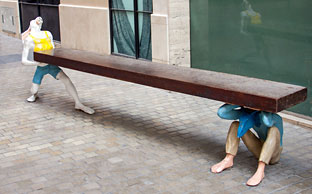 |
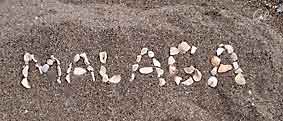 |
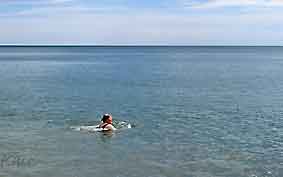 Litt kaldt i vannet, men likevel en deilig svømmetur. |
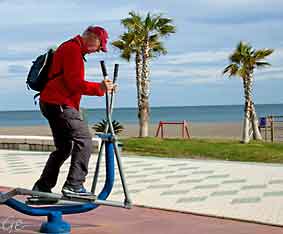 Litt trening må til på en ellers rolig dag |
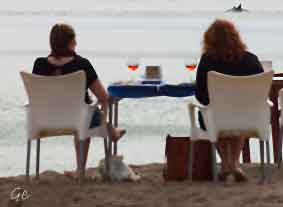 Andre nyter rosevin på stranda. |
Ut på tur igjen.
Denne gang til Ronda, en busstur på nesten 2 timer. Også denne
veien gikk gjennom innlandet bak kysten, men også her var det
mye fint å se.
Bussavgang kl 0930.
Retur til Malaga med toget. Toget kjører mye nede i en "grøft",
men likevel var det mye å se.
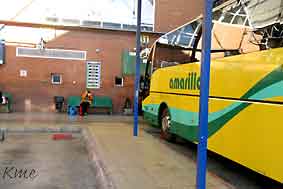 |
Ronda
ligger på en høyslette ca 750 m.o.h. litt innover i landet fra Solkysten og har rundt 35000 innbyggere. Byen ble opprinnelig grunnlagt av romerne under den andre punerkrigen. Som resten av Spania ble den imidlertid erobret av araberne på 700-tallet. I hele den islamske perioden var den en viktig by noe som betydde at muslimene satte sitt preg på arkitekturen i byen. I 1485 ble Ronda gjenerobret av de kristne, og det ble bygget nye bydeler basert på andre arkitektoniske prinsipper. http://www.reisemagazinet.no/ronda-spania/ |
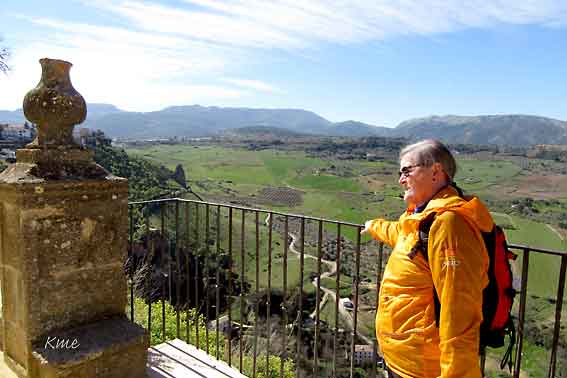
Grete i Ronda
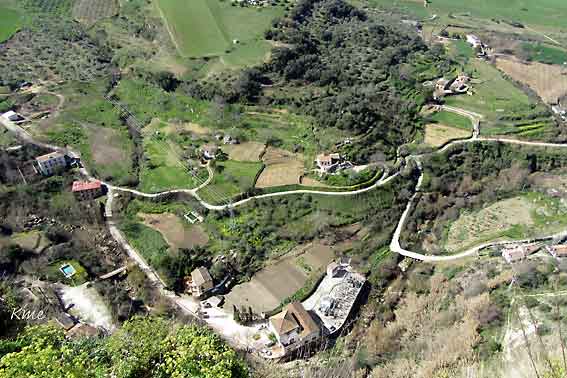
Ronda er en liten by i det sørlige Spania som tilhører provinsen Málaga i
den autonome regionen Andalucía. Den er en av Spanias eldste byer, og den
regnes som tyrefektingens vugge.
Fra Ronda til Málaga by, er det cirka 100 km, og byen ligger på en høyslette
på cirka 750 moh. Byen blir delt i to av en canyon: den 120 meter dype
kløften El Tajo («Hugget») med en tilhørende liten elv, skiller
den eldre, mauriske bydelen La Ciudad fra den yngre El Mercadillo.
Det finnes 3 broer over denne kløften, Puente Nuevo fra 1793, Puente Viejo
(Puente de la Mina) fra 1616 og Puente árabe (Puente de San Miguel) fra romertiden. Puente Nuevo er vakker og utsikten over kløften er
spektakulær. Dette er den viktigste grunnen til at Ronda er en svært populær
turistby på alle tider av året. Både Ernest Hemingway og Orson Welles
tilbrakte i sin tid store tidsperioder i denne byen, noe som også er med
på å trekke turister hit.
I Ronda finner man også den eldste tyrefekterarena i Spania som fortsatt
er i bruk. Dens navn er Plaza de Toros, og ble bygget i neoklassisk stil i
1784 av arkitekten José Martin de Aldehuela som også designet broen
Puento Nuevo.
https://no.wikipedia.org/wiki/Ronda
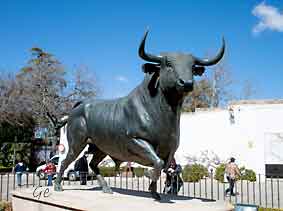 |
The
Ronda Bullfighting is located in the
beautiful city of Ronda, located near
Málaga in southern Spain. The bullring is
widely considered the oldest bullfighting ring
in Spain and definitely one of the most
beautiful and majestic in the world. It’s a
historic building, declared a Site of Cultural
Interest owned by the Real Maestranza de
Caballería de Ronda. Construction on the ring
began in 1780 and was concluded in 1785. And it’s no coincidence that Ronda is considered one of the cradles of modern bullfighting, which emerged during the eighteenth century, in a city that enjoys and deep and rich tradition in the art of cavalry that has been kept alive over the centuries. Ronda Bullfighting Ring: The oldest and one of the most beautiful bullrings in Spain - MAKESPAIN (19. desember 2022) |
RONDA
Despite being a growing town, Ronda retains much of its historic charm, particularly
its old town. It is famous worldwide for its dramatic escarpments and views, and for
the deep El Tajo gorge that carries the rio Guadalevín through its centre. Visitors make
a beeline for the 18th century Puente Nuevo 'new' bridge, which straddles the 100m
chasm below, before taking in the views from the Alameda out over the Serranía de
Ronda mountains.
Across the bridge, where an elegant cloistered 16th century convent is now an art
museum, old Ronda, La Ciudad, sidewinds off into cobbled streets hemmed by
handsome town mansions, some still occupied by Ronda's titled families.
The Casa de Don Bosco is one such, its interior patio long ago roofed in glass against
Ronda's harsh winters. Its small, almost folly-like gardens lose out, however, to the
true star, a few minutes' walk to the furthest end of the Ciudad, the Palacio Mondragón.
Clumsily modernised in parts during the 1960s, this still has working vestiges of the
exquisite miniature water gardens dating from its time as a Moorish palace during
Ronda's brief reign as a minor Caliphate under Córdoba in the 12th century.
http://www.andalucia.com/ronda/home.htm
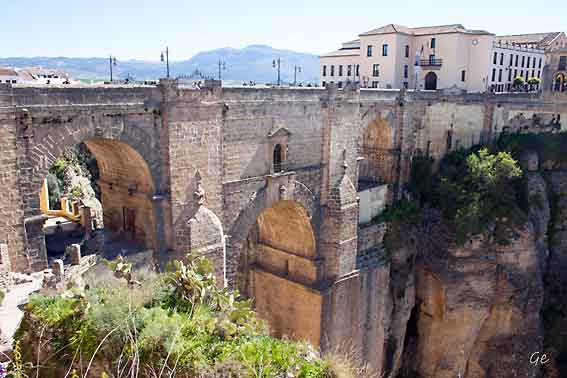
Puente Nuevo, Ronda
| Gate i
Ronda |
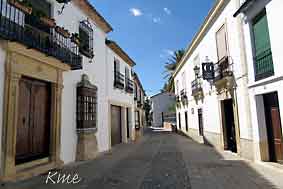 |
forbinder La Ciudad med den nyere bydelen El Mercadillo.
Veldig ny er broen riktignok ikke for den ble ferdigstilt allerede i 1793.
Men et imponerende byggverk er den utvilsomt med en høyde på 120 meter
over juvet som deler Ronda i to deler.
Under den spanske borgerkrigen hendte det at republikanerne kastet fanger
ned i kløften, noe som blant annet er beskrevet i Ernest Hemingways
roman «Klokkene ringer for deg«.
Fra La Ciudad er det en sti hvor man kan gå ned og beskue broen
og byen nedenfra.
http://www.reisemagazinet.no/ronda-spania/
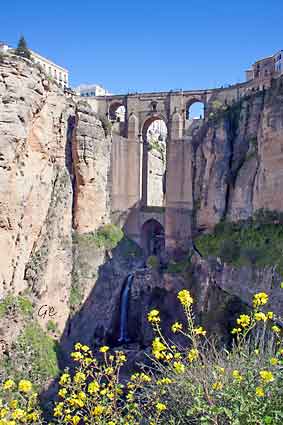 |
The Guadalevín River is a tributary of the Guadiaro River in Málaga, Andalusia, Spain. Its gorge divides the city of Ronda where it is spanned by three bridges, Puente Nuevo, Puente Viejo and Puente Romano. https://en.wikipedia.org/wiki/Guadalev%C3%ADn |
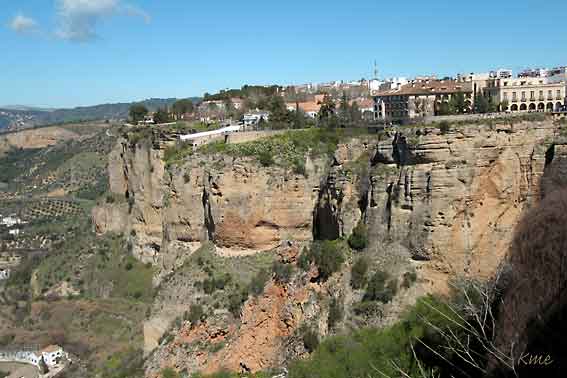
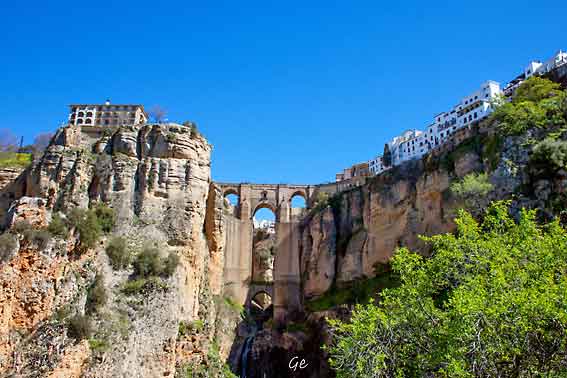
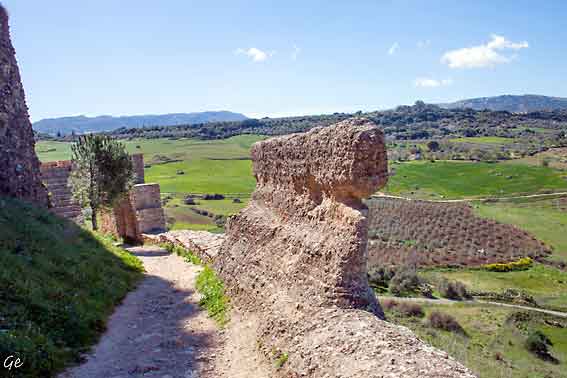
En rest av den gamle bymuren
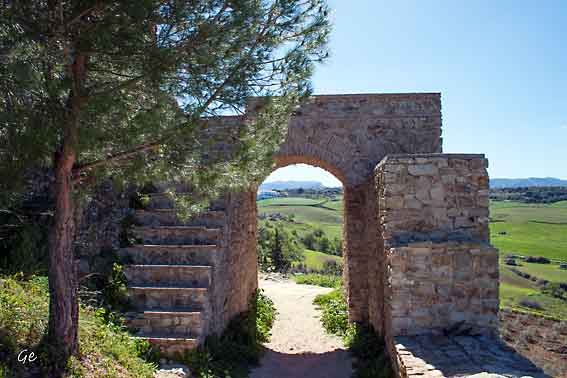
Puerta del Viento
Wind door is part of the west side of the city walls of Ronda , located in the
town of the same name, province of Malaga.
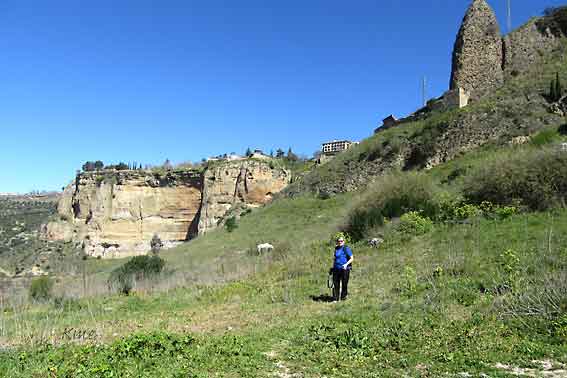
Vi gikk helt ned i dalbunnen nedenfor Ronda.
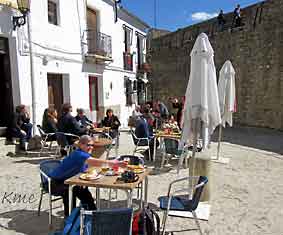 Lunsj på bar Sancez som ligger like innenfor La Puerta Almocabar La Puerta de Almocabar y sus murallas separan el Barrio de San Francisco de el de la Ciudad, dando acceso a la alcazaba y a la ciudad. |
Fue construida en el siglo XIII, esta completamente restaurada, el conjunto consta de tres puertas, con tres arcos en forma de herraduras entre dos torres con forma semicircular, (posiblemente fueron las torres asignadas a la guardia). Su nombre procede del árabe al-maqabi, que significa cementerio, ya que se encuentra cerca del antiguo cementerio musulmán. Fueron reestructuradas durante el período de Carlos V. http://malagapedia.wikanda. es/wiki/Puerta_de_Almoc%C3%A1bar_ (Ronda) |
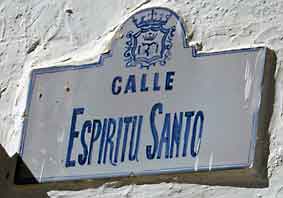 Gatenavn i Ronda |
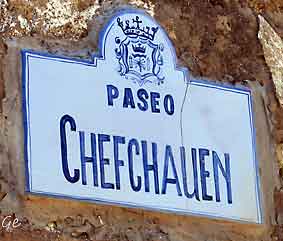 |
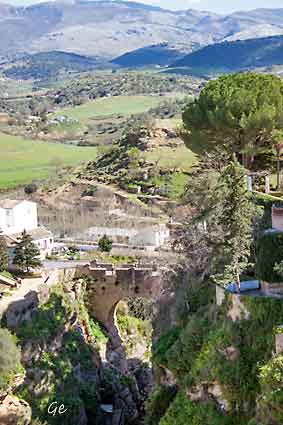 Ponte Viejo |
Ponte
Viejo Built in the 16th century, possibly on remnants of an earlier bridge, this was the one navigable link between Mercadillo and La Ciudad until the completion of the Puente Nuevo centuries later. Cars still need good gears and drivers with steely nerves to take the steep hairpin bend on the way up to the cuesta de Santo Domingo. The gate above the bridge, the Arco de Felipe V, from the same era, would have been the only entrance to La Ciudad from this end of the town, making it a key defence. The balconied niches on the bridge itself were introduced as part of an 18th century renovation. http://www.andalucia.com/ronda/ puenteviejo.htm |

Caminito del Rey i Chorro. Vi så den bare fra toget på vei tilbake til Malaga.
El Caminito del Rey (English: The King's little pathway) is a walkway, pinned along
the steep walls of a narrow gorge in El Chorro, near Ardales in the province of Málaga,
Spain. The name is often shortened to Camino del Rey (English: King's pathway).
The walkway had fallen into disrepair and was partially closed for over a decade.
After four years of extensive repairs and renovations, the walkway re-opened in 2015.
It has been known in the past as the "world's most dangerous walkway" following five
deaths in 1999 and 2000
https://en.wikipedia.org/wiki/Caminito_del_Rey
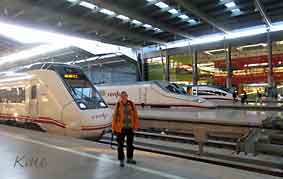 Jernbanestasjonen i Malaga, Maria Zambrano |
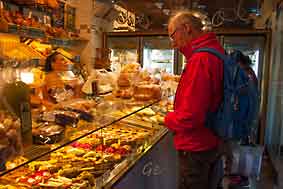 Bakeri i Malaga |
Som passasjer er det all grunn til å følge med ut av vinduet på store deler av
den to timer lange turen til Ronda. Det begynner å gå oppover ganske
umiddelbart etter at vi forlater Malagas drabantbyer, og i løpet av en drøy
halvtime er toget på stasjonen El Chorro, som er et utgangspunkt for gåturer
i fjellene.
Du får også se litt av den spektakulære naturen i dette området, med høye
bratte fjell og dype daler, men dessverre går mye av strekningen i tunnel.
Du bør likevel holde øynene åpne, for i de sekundene man er ute i dagslys
er det spektakulær utsikt!
http://www.erdetmulig.no/edm1287.php
Enda en dag vi skulle reise ut fra Malaga.
Denne gang til Nerja som er kjent for de store grottene.
Byen har også fine strender.
Turen gikk med buss. Veien fulgte kysten hele veien. Mye å se
her også.
Været: sol, 17 grader og lite vind

Foto Michelle Chaplow.
Bildet fra http://www.andalucia.com/nerja/eagle-aqueduct.htm
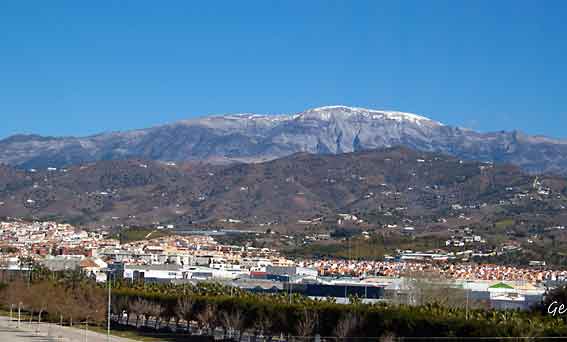
Nysnø på fjellet. Bildet er tatt fra bussen mellom Malaga og Nerja.
Til venstre:
Acueducto del Águila (Eagle Aqueduct), also known as Puente del Águila
(Eagle Bridge), is regarded across the region as "an historic jewel of
Spanish architecture". It was built in the 19th century and has been used
continuously since - today the local community uses it to irrigate farmland.
Akveduktet ligger i nærheten av Nerja
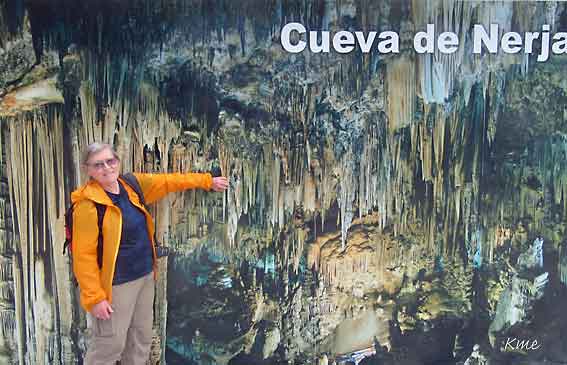
The site is steeped in both geological and archaeological interest; cave paintings
depict images of goats, horses, deer, seals and birds, drawn using red and black
pigments. The images have been dated between at 25,000 and 3,600 B.C.
http://www.andalucia.com/nerja/caves.htm
 |
Nerja
boasts 16 kilometres of beaches with powdery sand and sparkling clear water. All major water sports are available here, including water skiing, scuba diving and sailing. Flanked by a dramatic mountain range, Sierra Almijara, to the east, the town has, fortunately, managed to avoid being blighted by the concrete high-rise scenario which has been the inevitable result of the tourist boom in some of the |
winding streets, whitewashed houses with wrought iron terraces
overflowing with geraniums, on which a canary can sometimes be
heard singing...
http://www.andalucia.com/nerja/home.htm
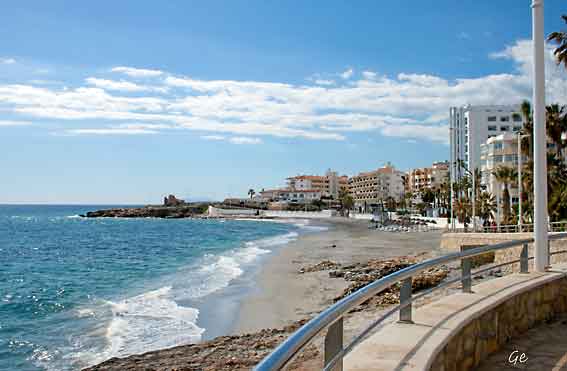
Strand i Nerja
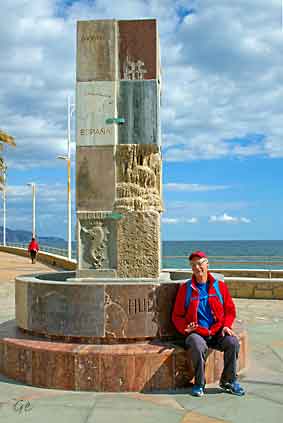 |
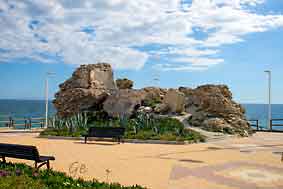 The Beaches of Nerja are one of the towns´s biggest assets, the crystal clear waters and rocky outcrops the pepper the coastline make it a haven fosnorkelling and scuba diving. The steep cliffsides offer breath taking views; of course none as spectacular as that of the Balcon de Europa. The shape of the coves mean the waters are tranquil and the beaches protected from harsh winds. Restaurants, kiosks and chiringuitos scattered along the shoreline ensure that the beaches of Nerja are unmissable and well catered; a haven for both tourists and locals. http://www.andalucia.com/nerja/beaches.htm |

Grete i Nerja
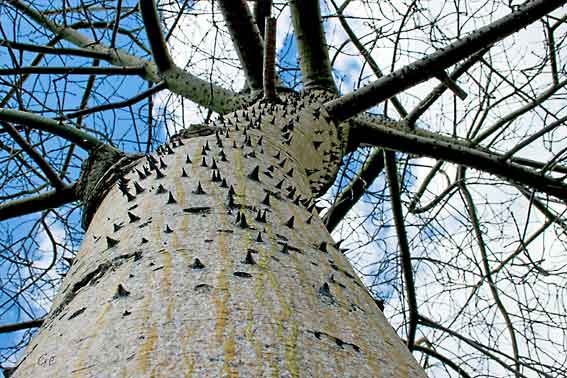
Ceiba chodatii. Bildet er tatt utenfor grottene i Nerja

Samme sort tre fotografert i Malaga.
Her sto det hva slags tre det var. Ceiba Chodatii
Enda en dag ut av Malaga, denne gang til Mijas.
Det var ikke så lang tur fra Malaga,
men turen gikk med lokalbuss og brukte veldig lang tid, fordi
"alle" skulle til Mijas den dagen, spesielt pensjonister.
Været: fint vær
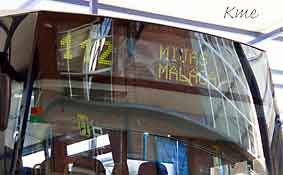
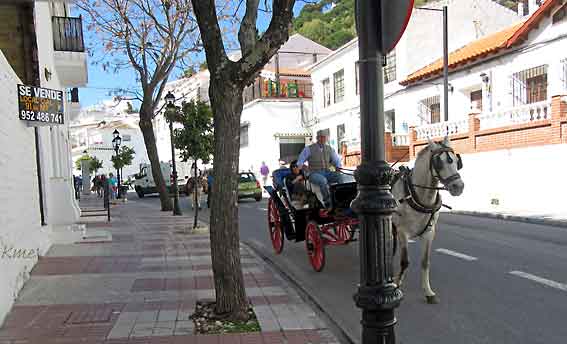
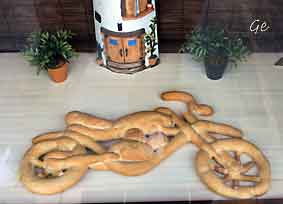 |
 Utstillingsvinduer hos bakere i Mijas |
which nestles comfortably in the mountainside at 428 meters above sea
level; it is a superb choice for either holiday or full time living. Of the
7,500 population, there are so many foreign and English speaking
residents in and around the pueblo that the Town Hall has a very h
elpful Foreigner's Department, which caters for the many needs of
those who do not speak Spanish.
http://www.andalucia.com/mijas/pueblo.htm

Grete beundrer utsikten over Costa del Sol
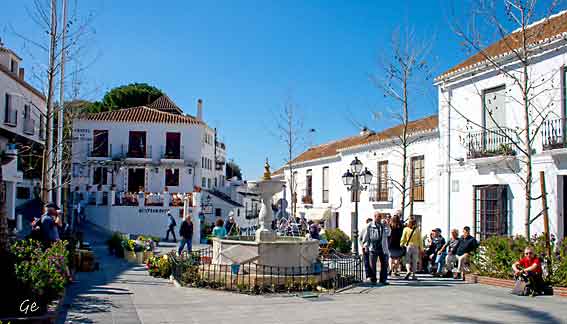
Torget i Mijas
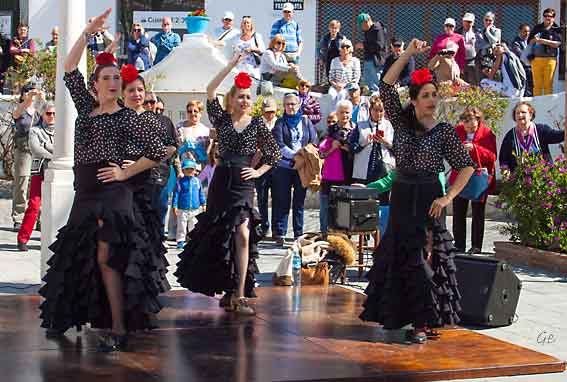
Flamenco history has only been documented for the past two hundred years
or so, and anything before this time is open to debate and speculation.
Much of what we know from before this time comes from stories and legends
that have been passed down through family dynasties, in a similar way to the
flamenco song itself.
http://www.andalucia.com/flamenco/history.htm
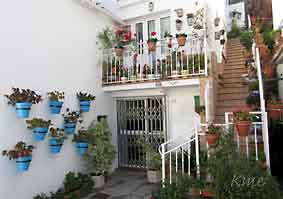 Flamenco: One thing we can be sure of is that flamenco in its original form was only voice, a primitive cry or chant accompanied only by the rhythm which would be beaten out on the floor by a wooden staff or cane. These
styles are known as Palo Secos, history.htm |
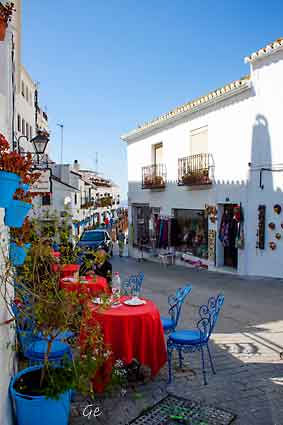 |

 Lunsj på plassen utenfor kirken. Cafeteria la Muralla |
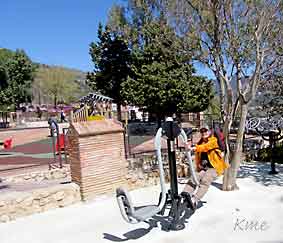 og så litt trim etter maten |

Under til høyre: (to the right, below:) Santuario de la Virgin de la Pena
The shrine of Our Lady the Virgin of the Rock was excavated in the rocks
by a Carmelite monk in the second half of the seventeenth century.
The legend says that the virgin appeared between the walls of the old
castle in 1586 were it remained hidden during the 8 centuries of the
muslim domination of the Spain.
After the conquest by the Catholic Kings of the last strongholds of Granada.
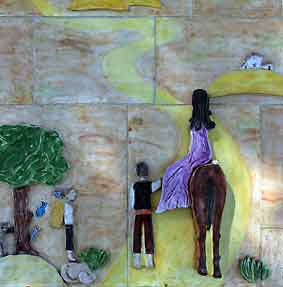 |
 "La Imaculada Concepción" or The Immaculate Conception |
La Ermita de la Virgen de la Peña de Mijas is a monastery and Catholic holy site in
Mijas, Malaga province, Spain. It was excavated in the rock around 1548 by
Mercedarian friars. According to tradition, Marian apparitions began in 1586, when two
children, Juan and Asuncion Bernal Linaire, are credited with having a vision of Mary
above the church. According to the tradition, they saw a white dove on the tower of the
Castillo which transfigured into the virgin and notified their father, who reported the hiding
place to the local church authorities of Mijas.
After the conquest of Andalusia by the Crown of Castile, legends and reports of Marian
apparitions multiplied.
The Virgen de la Peña is the patron saint of
Mijas
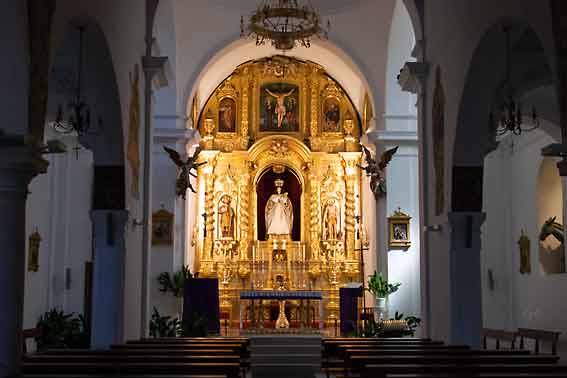
Parish Church - The Immaculate Conception Church began to be built in the second half of the 16th century and was finished in 1631, with three naves and
a chapel under which there is a burial crypt. Later they went adding new parts
to the church such as another Baroque chapel with its crypt. The church was
built adjoining the "Torre de la Vela" tower, which became its bell tower. This
tower was built in the mid-sixteenth century as a shelter to the Mijas villagers
in case of an attack. In 1992 reform works were carried out and it was then
that the 8 apostles paintings were discovered on the columns of the church,
these paintings dated back to 1632.
Parish Church - Paseo de la Muralla, Mijas | The area in Mij… | Flickr (27. januar 2022)
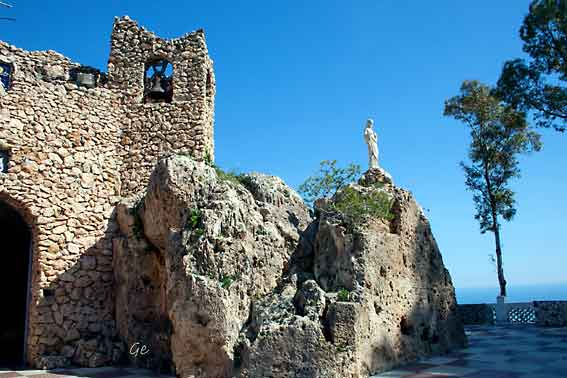
Santuario de la Virgin de la Pena
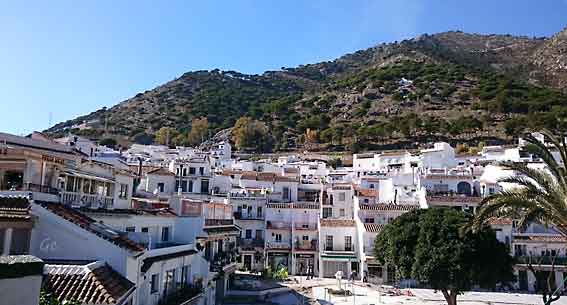
Mijas
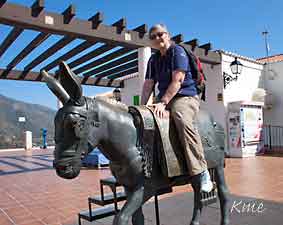 Grete tar seg en ridetur |
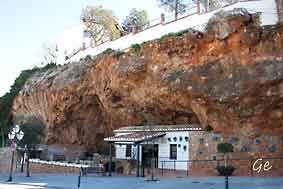 Mijas svar på huset under helleren i Jøssingfjord. |
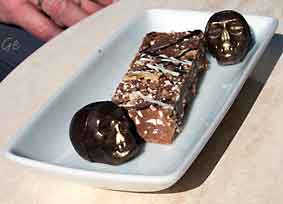 |
Besøket i
Mijas ble avsluttet med kaffe og kaker på et konditori. |
It is one of the only Ancient ruins left in Málaga after the outwardly Republican
city was bombed by Nationalist sympathizers - the Italian army during the Civil
war, and one of the only remaining Roman ruins in Andalucía after centuries of warfare, and construction.
The site is accompanied by the Centro de Interpretación (visitors centre) which
teaches visitors about the history of the ruins and its subsequent excavation
(bildet til høyre)
http://www.andalucia.com/cities/malaga/teatro-romano.htm
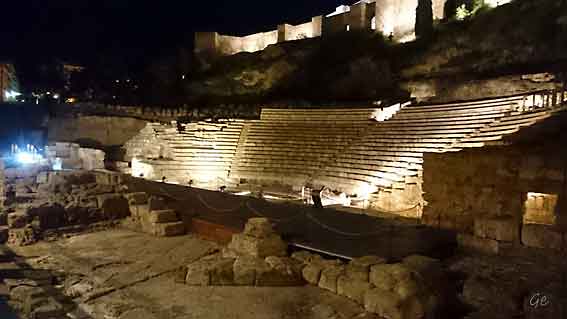
Det romerske teater i Malaga
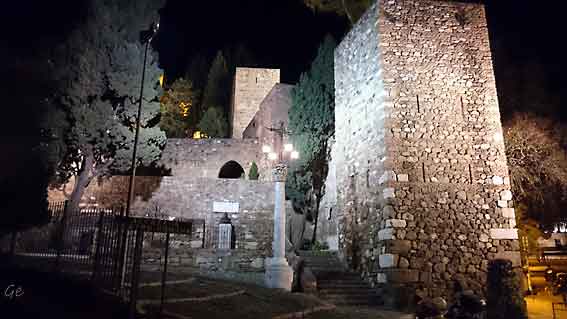
Alcazaba i Malaga
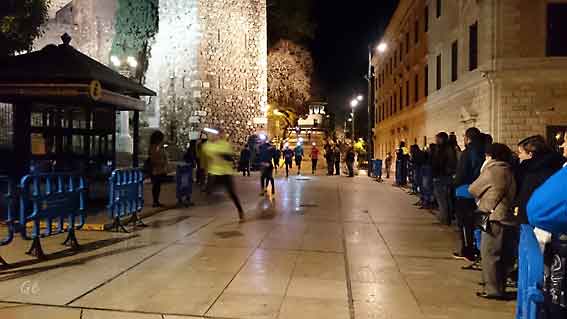
Gateløp i Malaga. Deltakerne løp opp til Gibralfaro (116 moh) og ned igjen
Værmelding: Pent vær, lite vind, ca 16 grader.
Ingen bestemte planer for dagen.
Bare rusle rundt i byen og slappe av.
Katedralen i Malaga lå like ved hotellet og vi gikk
dit for å se mer på den.
Etterpå tenkte vi å besøke museet Santa Semana,
siden det nærmet seg påske.
Men det ble ikke noe besøk der likevel.
Grete tok med badetøy siden det var meldt fint vær.
 |
Først var
vi på et nytt besøk i Katedralen La Manquita. |


Katedralen La Manquita
 Bare en uke igjen til påske og påskeforberedelsene er i gang i alle byens kirker. |
 Iglesia de San Agustin |
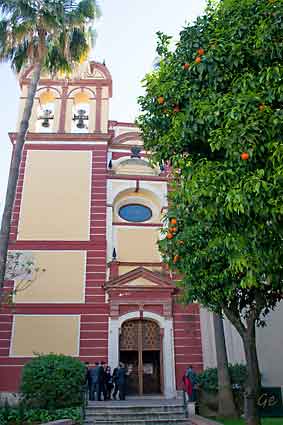 Iglesia de San Agustin |
16th
Century. Located in the old Calle de los Caballeros, now called Calle San Agustín, this building has three parts: church, school and monks' residence. The church's beautiful courtyard is next to the Museo Picasso Málaga (Málaga's Picasso Museum), on one of the streets that best preserves its original structure. The church has three naves, the central one being covered by a barrel vault and lunettes set off by mouldings. The church is very bright because of the alternating spans in the arches that rest on Corinthian pilasters thought to be in the style of José Martín de Aldehuela. The convent has always been linked to teaching work. Convento de San Agustín Church - Monuments - Visita Málaga (malaga.eu) (19. desember 2022) |
 |
De lå et
stort cruiseskip i havna. De ville vi se nærmere på. På veien var vi innom en restauranten Kaleido og kjøpte is, og noe å drikke til den. |
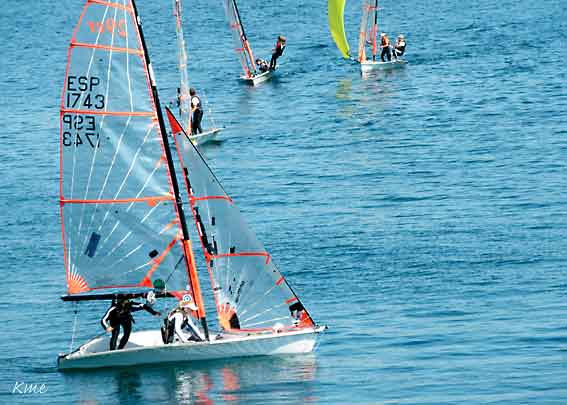
Kurs i seiling
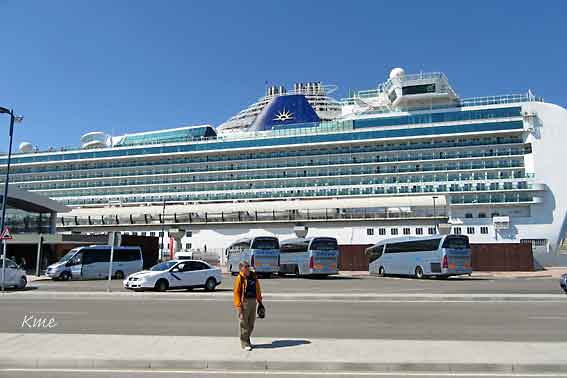
Grete foran cruiseskipet Ventura
Ventura in numbers
116,017 Tons | 3,078 Guests | 1,205 Crew

Så gikk vi til stranda. På tide med litt bading og soling.
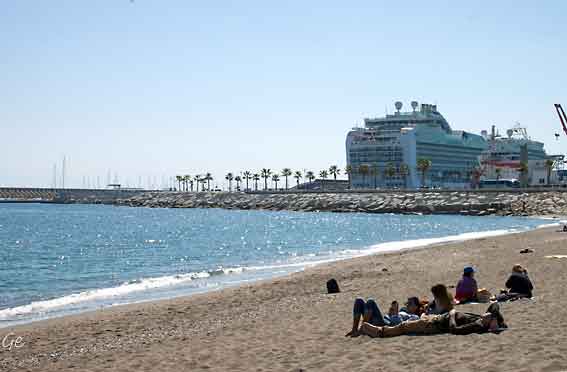
Det var en fin, varm søndag ettermiddag og ganske mange hadde
funnet veien ned til stranda.
Værmeldingen sa at det skulle skye til.
Det gjorde det heldigvis ikke,
men lufta ble litt kjøligere enn dagen før.
Vi hadde ikke bestemte planer for dagen, men det ble til at
vi tok en tur til opp til Gibralfaro.
Etterpå gikk vi ned på stranda igjen.
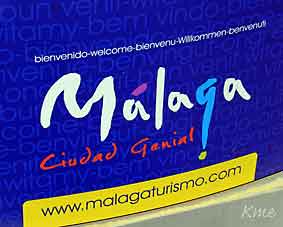
 Malagas smaleste gate? |
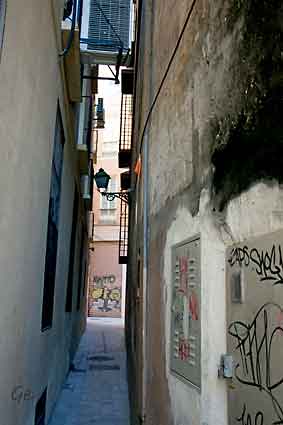 |
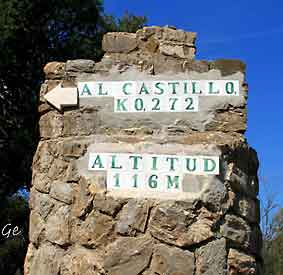 Så høyt kommer man med bil og buss. |
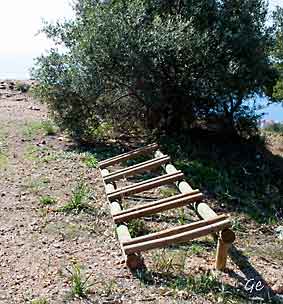 Med sykkel eller til fots kommer man noen meter høyere. |
passasjerer 4100 og et mannskap på 1708
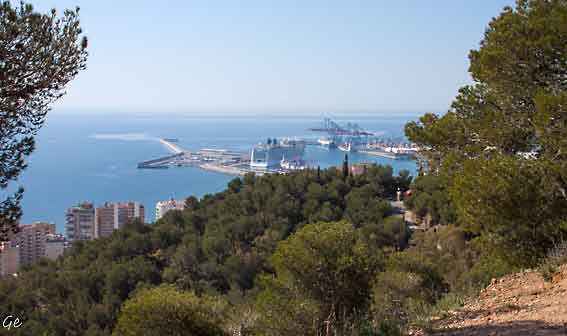
Utsikten er fin. Dagens cruiseskip er Norwegian Epic.

| Mount Gibralfaro, Spanish:
Monte Gibralfaro, is a hill located in Málaga in southeast Spain. It is a 130 m high foothill of the Montes de Málaga, part of the Cordillera Penibética. https://en.wikipedia.org/wiki/Gibralfaro |
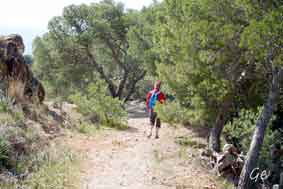 Karl Martin er på vei ned igjen fra toppen av Monte Gibralfaro |
La Malagueta itself was built in 1874, by the architect Joaquín Rucoba.
The first fight took place on 11th June 1876, and the matadors who fought were
Rafael Molina, Antonio Carmona, Luque El Gordito, and Manuel Rodriguez.
A century later in 1976 the site was declared an Historic Artistic Monument,
and in 1981, it was declared an Official Site of Cultural Interest.
http://www.andalucia.com/cities/malaga/plaza-de-toros.htm
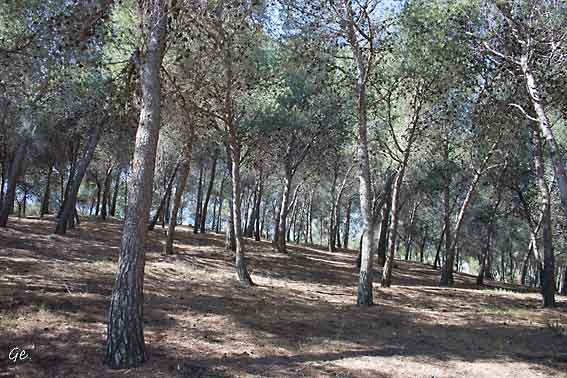
Skog på Monte Gibralfaro
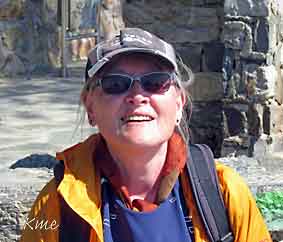 |
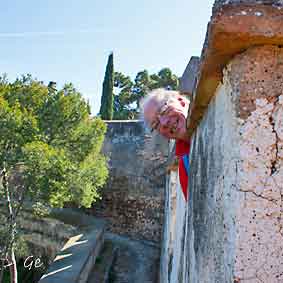 |

Vi fant en lite brukt sti ned fra Gibralfaro. Vi regna med at den førte
ned til byen. Stien ble smalere og smalere, men vi kom ned.
| Den ukjente
stien førte ned til en kirkegård. Kirkegården fotograferes av Grete. Denne gangen fra utsiden av gjerdet. |
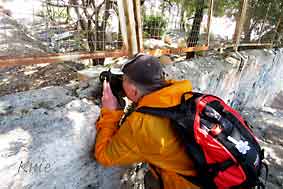 |
English Cemetery
When William Mark arrived in Malaga in 1816 to take up his post as British Consul,
he was astonished and horrified to learn that in Spain burial in consecrated ground
was reserved exclusively for Catholics. Protestants were buried without rites and in
Malaga the burials were bizarre.
http://www.andalucia.com/cities/malaga/english-cemetery/cemetery-history.htm
who successfully appealed to the Governor for a piece of land on which to provide
British subjects of the protestant faith with a decent burial.
http://www.significantcemeteries.org/2013/07/the-english-cemetry-malaga-spain.html
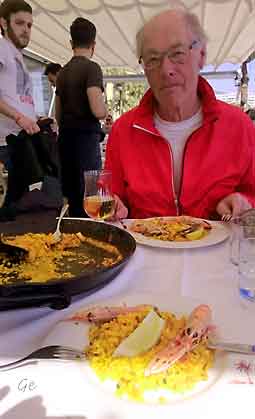 Paella på Chiringuito Tropicana, Malagueta |
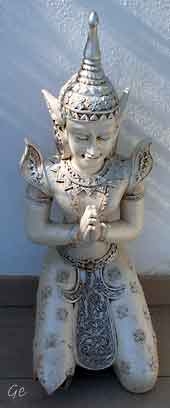 |
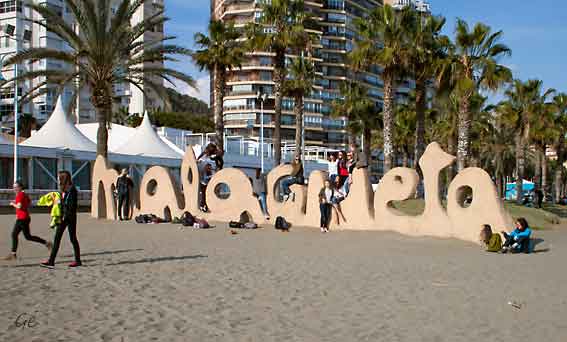
workers over a wood fire for the lunchtime meal. It was made with rice,
plus whatever was to hand around the rice fields and countryside:
tomatoes, onions and snails, with a few beans added for flavour and
texture. Rabbit or duck might also have been added, and for special
occasions, chicken plus a touch of saffron for an extra special colour and
flavour. Paella was also traditionally eaten straight from the pan in which
it was cooked with each person using his own wooden spoon.
Little by little, as 'Valencian rice' became more widely available, paella
recipes were adapted with new variations appearing. With Valencia
being on the coast, it is no surprise that various types of seafood crept
into the recipes over the generations. Now paella is the generic name of
200 or so distinctive rice dishes or ‘arroces’ from the Valencia region let
alone other parts of Spain and the rest of the world. To this day a "true"
Paella Valenciana has no seafood but a mixture of chicken, rabbit and
snails with green and white beans.
https://www.thepaellacompany.co.uk/history.html
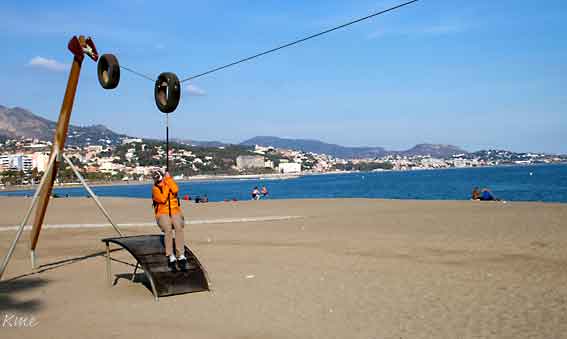
Grete leker seg på stranda
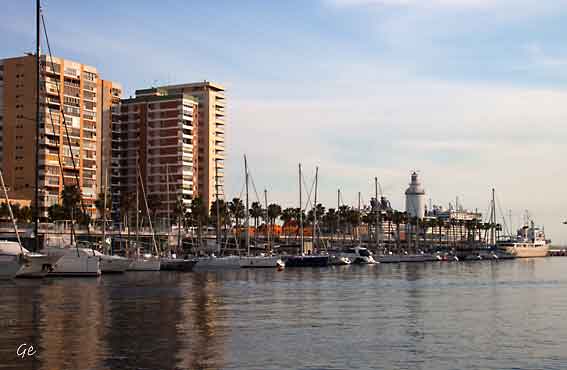
Det går mot kveld i havna
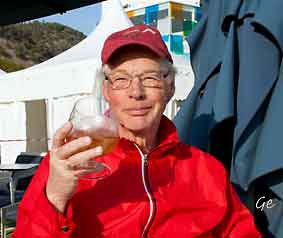 |
Dette var
den siste kvelden vår i Malaga. I hvertfall for denne gang. Neste morgen skulle vi reise videre til Cordoba. Vi tok avskjed med havna med et glass amaretto. |
meaning "bitter", which references the distinctive flavour lent by the mandorla
amara (the bitter almond) or by the drupe kernel. However, the bitterness is not
unpalatable, and sweeteners—and
sometimes sweet almonds—enhance the flavour in the final products.
Thus one can interpret the liqueur's name as a description of the taste as
"a little bitter". Conflation of amaro ("bitter") and amore ("love") has led to
associations with romance.
https://en.wikipedia.org/wiki/Amaretto
Etter ti netter i Malaga var det tid for å flytte nordover.
Vi tok tog til Cordoba. Der skulle vi være to netter.
Togturen til Cordoba tar ca 1 time.
Fra jernbanestasjonen i Cordoba til hotel Eurostar Palace
var det bare 700 meter, så den strekningen gikk vi.
Ut fra stasjonen tok vi feil vei, så for oss ble det noe lenger.
Vi kom så tidlig til Cordoba at vi rakk å se litt av bymuren,
Alcazar de los Reyes Cristianos, Puente Romano og Torre
de la Calahorra i løpet av dagen.
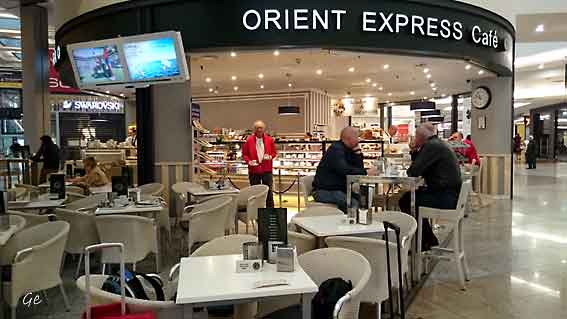
Det nærmeste vi kommer Orientexpressen.
Cafeen er på Maria Zambrano, jernbanestasjonen i Malaga.
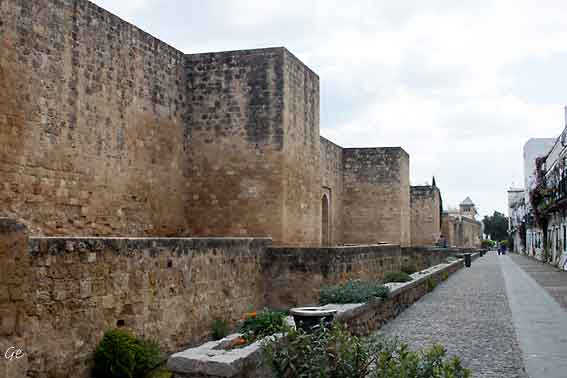
Cordoba will forever bear the imprint which its Roman, Moorish and Christian
rulers left on the city, adapting its streets to its city walls. The Romans proved
to be the most influencial, and their layout of the main city lasts to this day.
Their walls were maintained by the Moors and later Christian rulers.
Extensive portions of these walls still stand today. Below is a map of this
historic walled city, followed by an article describing the history of Cordoba
and its walls:
http://www.infocordoba.com/spain/andalusia/cordoba/city_walls.htm#roman
 The Alcazar (of the Christian Kings) features a castle its delightful gardens and a moorish bathhouse. This is a very popular monument. A Muslim Alcazar once stood where the Episcopal Palace is today - this building was reformed in the Baroque period and was recently reconditioned in order to house the Diocesan Museum. |
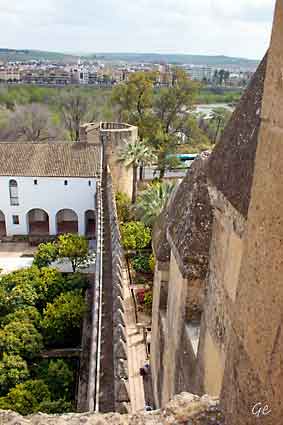 |
of San Jacinto and the Hospital ofSan Sebastian, an outstanding construction
opposite the Mosque featuring a portico that stands out among the Gothic jewels in
Cordoba.
Inside, in the Romero de Torres hall,one can admire interesting 16th century frescoes.
Despite originating from the Christian era, these gardens are typically Moorish in
design with ponds, fountains and aromatic plants. Adjacent to the gardens are the
Royal Stables which extend to encompass the Gardens of the
Campo Santo de los Márties.
The castle is almost a perfect square in plan of 4.100 square metres. It was rebuilt
in 1327 by King Alfonso XI. His aim was to bring European Gothic architecture to
the town. The castle walls connect the four (now three) corner towers by walkways
or allures protected by battlements with prism shaped blocks.
http://www.andalucia.com/cities/cordoba/alcazar.htm
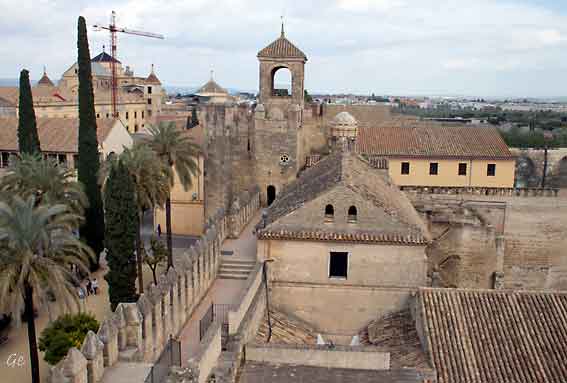
Alcazar de los Reyos Cristianos
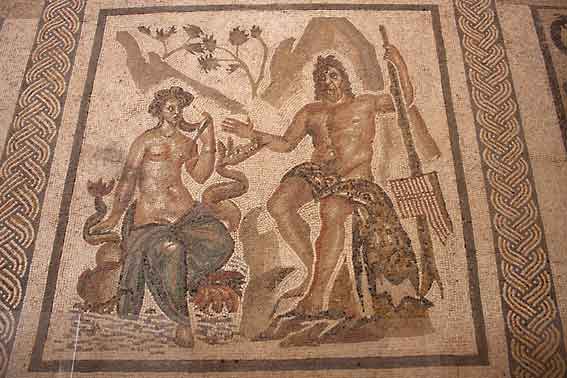
This work —one of the most important of the Roman Empire— represents a
love scene inspired by the Hellenistic poem "The Cyclops". It is a mythological
work that served as an inspiration to the Cordoban poet and dramatist
Luis de Góngora y Argote to write the fable "Polyphemus and Galatea".
http://www.alcazardelosreyescristianos.cordoba.es/?id=640&lang=3

The gardens of the Alcázar stand on the site of the former vegetable gardens
of the Alcázar, which were surrounded by the walls of the fortress. They were supplied with water from the river via a complex irrigation system.
http://www.alcazardelosreyescristianos.cordoba.es/?id=601
Christopher Columbus wins the Spanish monarchs' support
After years of waiting, and with the help of a former official of Isabel and monk
from La Rábida monastery, he was able to gain another hearing in 1491 with
Isabel's royal commission in Santa Fe, outside the besieged Granada. They
considered his project once more, and once more it was rejected. Columbus set
out again for Cordoba, from whence he planned to travel north to make an appeal
to the king of France.
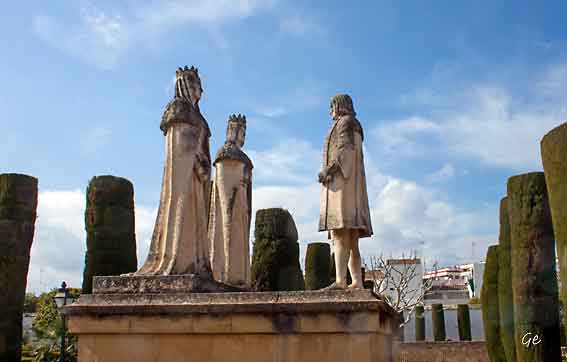
Christopher Columbus wins the Spanish monarchs' support
Luckily for Columbus
(and for the Spanish monarchs), the shrewd King
Ferdinand intervened, causing a last-minute
about-face which sent messengers
scrambling after Columbus to bring him back to
court.
They didn't think Columbus would come back alive
from his expedition,
but they certainly didn't want to lose out on the
benefits if he did.
Perhaps their lack of faith in the voyage was why
they granted him 10% of
the profits, noble status and hereditary
governorship of the new territories to
him and his descendants if he succeeded.
Columbus pays one last visit to family in Cordoba before his historic voyage
April 17, 1492
Ferdinand and Isabel signed the formal agreement
with Columbus,
who left Granada in May. On his way to the Huelva
coast, where he would outfit
his expedition, he passed through Cordoba to see
Beatriz and his son Hernando,
then 5. No doubt he wondered if it would be the last
time he saw them.
Three months later, on August 3, his expedition set
out from Palos on the
Niña, Pinta and Santa Maria and sailed into the
unknown.
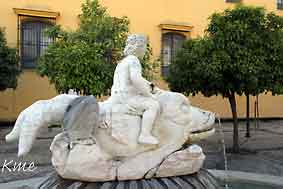 |
På plassen
med statuen av engelen Gabriel og Puerta Puente står denne skulpturen av en gutt på en delfin. |
from the city centre. It is a fortified gate originally built by the Moors (Almohads)
and extensively restored by King Enrique II of Castile in 1369 to defend the city
from attack by his brotherPedro I the Cruel from the South. It was origionally an
arched gate between two towers. Enrique II added a third cylindrical shaped
tower connecting the outer two.
In the 18th century it was used as a prison and in the 19th century it was a girls
school. The tower was declared a national monument in 1931. the restoration of
the tower and the Romain bridge and the surrounding area in 2007 was awarded
the EU prize for cultural heratige "Europa Nostra" in 2014.
http://www.andalucia.com/cities/cordoba/calahorra.htm
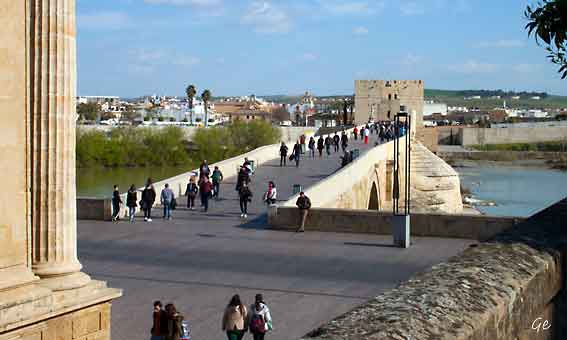
Puente Romano. På den andre siden av broa ligger Torre de la Calahorra.
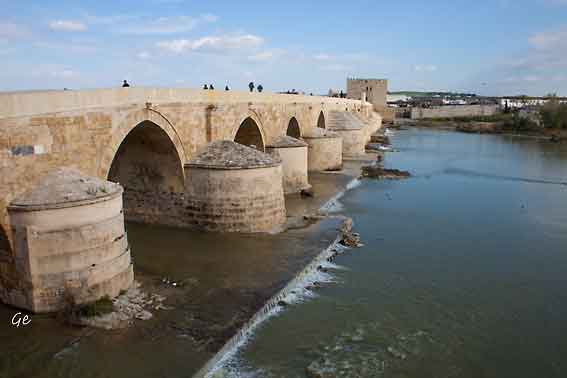
The Roman bridge which, according to the Arab geographer, Al-drisi 'surpasses
all other bridges in beauty and solidity', reflects little of its Roman roots, owing
to frequent reconstruction over many decades. In the centre of the eastern side's stone handrails there is a little shrine to St Raphael, at whose feet the
devout burn candles.
It is, of course, unlikely that much of the original structure stands. The present
structure is a medieval reconstruction, though the 19th-century cobbled paving
does give a Roman feel. There is an irregular pattern to the 16 arches in size
and abutment protections.
http://www.andalucia.com/cities/cordoba/romanbridge.htm
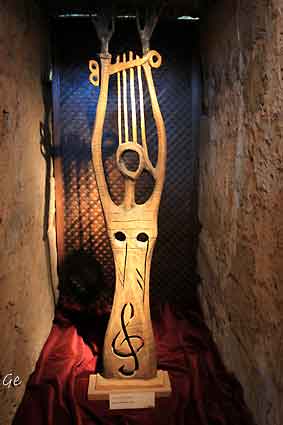 |
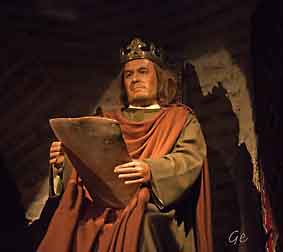 It currently houses the Museo Vivo de Al-Andaluz . This fascinating museum is particularly educational with audio visual presentations which vividly depict how life was in Cordoba around the 10th Century AD when three cultures lived side by side Christianity, Muslim and Judaism. |
 |
There is a scale model of the
Mosque as it was ini Mooris times before the cathedral was constructed. http://www.andalucia.com/cities/cordoba /calahorra.htm |
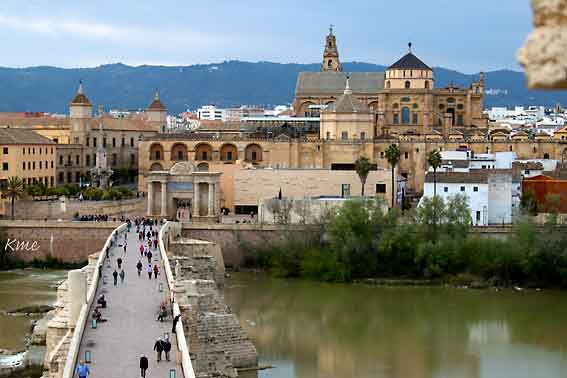
Visitors are also able to go on the roof for a spectacular view
of the mosque and the city.
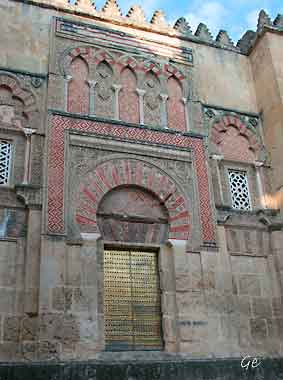 |
En dør inn
til Mezquita Vi var en tur inn i hagen utenfor katedralmoskeen. Det var blitt langt på dagen, og vi regnet med å bruke litt tid inne i Mezquita. Dessuten hadde vi allerede sett mye i Cordoba og trengte å fordøye inntrykkene før et besøk i Mezquita. Derfor gikk vi ikke inn denne ettermiddagen. |
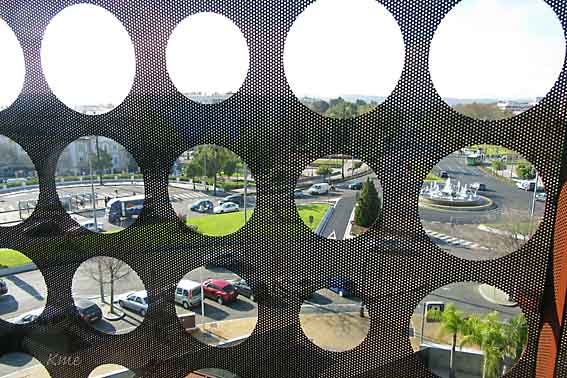
Utsikt fra rommet vårt på hotel Eurostar Palace. Vi bodde midt i en
stor rundkjøring, men hotellet var godt isolert og vi var ikke plaget av
trafikkstøy
 |
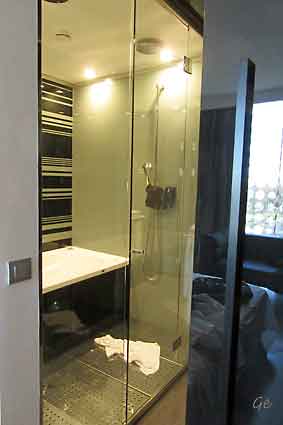 |
 |
Cordoba
was founded by the Romans and due to its strategic importance as the highest navigable point of the Guadalquivir River, it became a port city of great importance, used for shipping Spanish olive oil, wine and wheat back to Ancient Rome. The Romans built the mighty bridge crossing the river, now called "El Puente Romano". But Cordoba's hour of greatest glory was when it became the capital of the Moorish kingdom of El-Andalus, and this was when work began on the Great Mosque, or "Mezquita", which – after several centuries of additions and enlargements – became one of the largest in all of Islam. |
rulers of the city were so awed by its beauty that they left it standing, building
their cathedral in the midst of its rows of arches and columns, and creating the extraordinary church-mosque we see today.As well as the unique
mosque-cathedral, Cordoba's treasures include the Alcazar, or Fortress,
built by the Christians in 1328; the Calahorra Fort, originally built by the
Arabs, which guards the Roman Bridge, on the far side of the river from the Mezquita, and the ancient Jewish Synagogue, now a museum.
Cordoba's medieval quarter, once the home of the Jewish community, is called
"La Judería" (The Jewry), a labyrinth of winding, narrow streets, shady
flower-filled courtyards and picturesque squares such as La Plaza del Potro.
In early May, homeowners proudly festoon their patios with
flowers to compete for the city's "most beautiful courtyard" contest
http://www.andalucia.com/cities/cordoba.htm
The Synagogue, situated in the heart of the Jewish Quarter of Cordoba, is unique in Andalusia and one of the three best preserved Medieval synagogues in the whole of Spain. According to the inscriptions found in the building, it was built between the years 1314 and 1315, and was in constant use right up until the Jews were finally expelled from Spain. A small courtyard leads to a narrow entrance hall. On the right, a staircase leads to the women’s area and in front lies the main hall, which is rectangular in shape and decorated with Mudejar-style plant motifs. The wall supporting the women’s tribune has three arches with exquisite decorative plasterwork. |
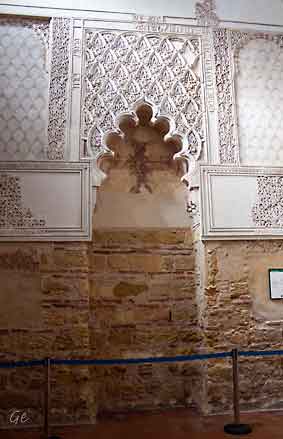 |
hospital, then as the Hermitage of San Crispin and finally, an infants’ school.
It was declared a National Monument at the end of the 19th century.
https://www.turismodecordoba.org/synagogue
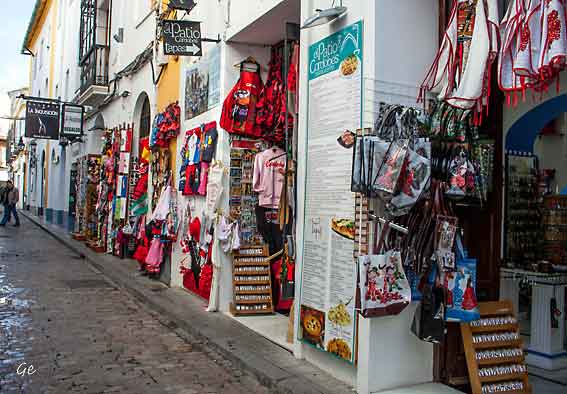
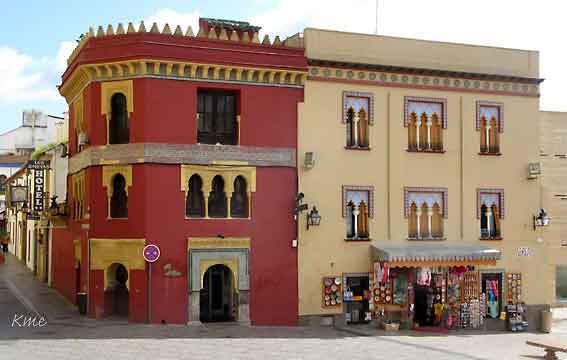
| Patio de los Naranjos The appearance of the courtyard has undergone many changes in the course of history. One important change was when it was extended to the north during the reign of Abd al-Rahman III, when the former minaret of Hixem was knocked down, or the extension to the east carried out by Almanzor. In Islamic times, the area was used for public events such as administering justice or teaching, and the arches connecting the courtyard with the main body of the mosque used to be open. It was intended from the very start as a courtyard with porticos (the galleries were started by Abderramán I and finished in the time of Hixem I, who built the minaret and the ablutions hall). However, the cloisters visible today date from the beginning of the 16th century, when Bishop Martín Fernández de Angulo entrusted the architect Hernán Ruiz I with the task of totally rebuilding them. Beneath the ground where the orange trees are planted lies a large water cistern |
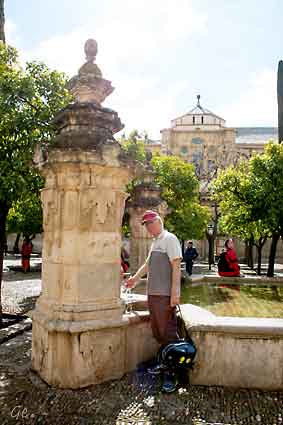 which ensured in Moslem times a constant supply of water for the ritual ablutions.The first mention of palm trees being planted here goes back to the 13th century, and there were orange trees in the 15th century, with olive trees and cypresses being added in the 18th. The Orange-tree Courtyard | Turismo de Córdoba (turismodecordoba.org) (19. desember 2022) |
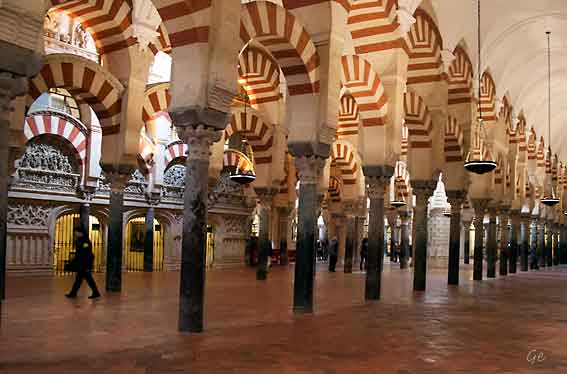
Mezquita
The Mosque-Cathedral of Cordoba is the most important monument
of all the Western Islamic world, and one of the most amazing in the world.
The evolution of the “Omeya” style in Spain is resumed in the history of the
Mosque of Cordoba, as well as other styles such as the Gothic,
Renaissance and Baroque of the Christian architecture.
It seems as if the place that the Mosque-Cathedral of Cordoba occupies
nowadays was dedicated, from ancient times, to the cult of different
divinities. In this same place, and during the Visigoth occupation,
another building was constructed, the “San Vicente” Basilic.
http://www.catedraldecordoba.es/
Elmonumento.asp?idp=7&pag=1
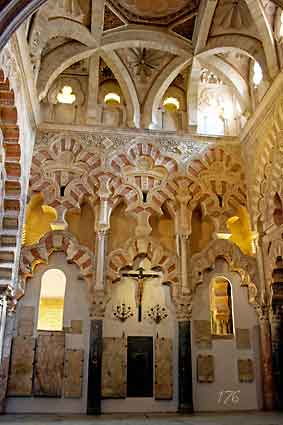 |
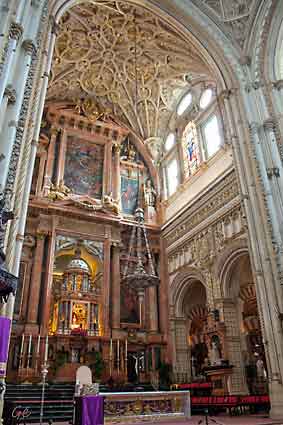 |
|
|
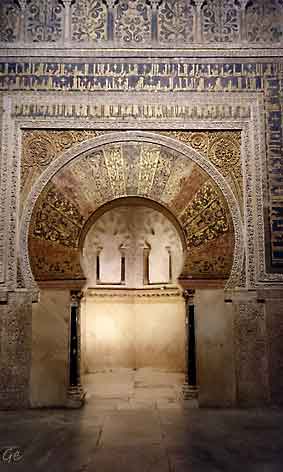 |
Today, Mihrabs vary in size, are usually ornately decorated and often designed to give the impression of an arched doorway or a passage to Mecca. In exceptional cases, the mihrab does not follow the qibla direction. One example is the Mezquita of Córdoba, Spain that points south instead of southeast. Among the proposed explanations, there is the localization of theancient Roman cardo street besides the old temple the Mezquitawas built upon. https://en.wikipedia.org/wiki/ Mihrab |
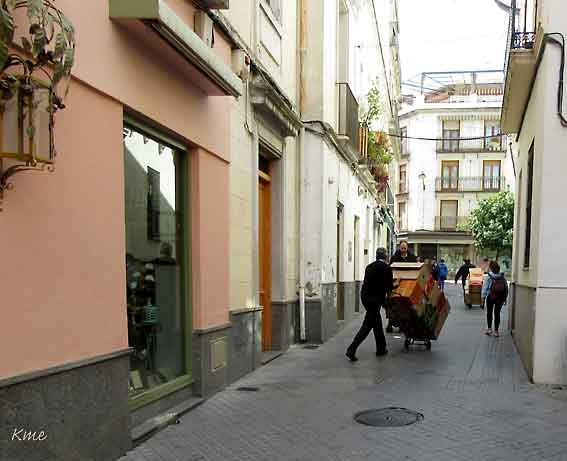
Varetransport i gamlebyen
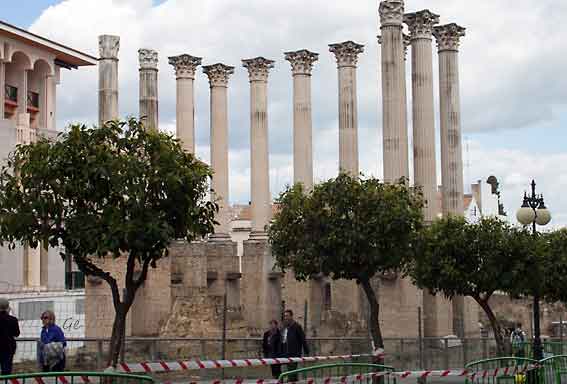
Next to the Town Hall of Cordoba stands the only Roman temple in Cordoba
for which we have archaeological evidence. The sheer size of the building is
remarkable: it was dedicated to the cult of the Emperor, and along with the
Circus Maximus, formed part of the Provincial Forum. It originally stood on a
raised podium and had six free-standing Corinthian columns in the entrance.
In front of this was the ara or altar. The present reconstruction was carried
out by the architect Félix Hernández, and has left Cordoba yet another
reminder of the splendour of the city in Roman times. Some of the original
pieces from the museum are on display in the Archaeological Museum or in
unusual but attractive places dotted around the city, like the fluted column
lying in Plaza de la Doblas.
https://www.turismodecordoba.org/roman-temple
Farvel til Cordoba. Madrid neste stopp.
Reisen tok i underkant av to timer med tog.
Farten var neste 300km/t det meste av veien og det var
en meget behagelig reise.
Vi var fullstendig ukjente i Madrid, og derfor tok vi taxi fra stasjonen
til hotellet. Hotel Avenida Gran via var et mye enklere hotell enn det
vi kom fra, men helt ok.
Avenida Gran Via (Storgata) som er en av hovedgatene i byen var
bare 50 meter unna. Det gjelder å bo sentralt.
Etter innsjekking på hotellet gikk vi ut for å gjøre oss kjente i nærområdet.
Fra hotellet var det gangavstand til Puerta del Sol, Plaza Mayor,
Palacio Real og mange stor butikker og kjøpesentre.
More about Madrid here: 33 things to do in Madrid
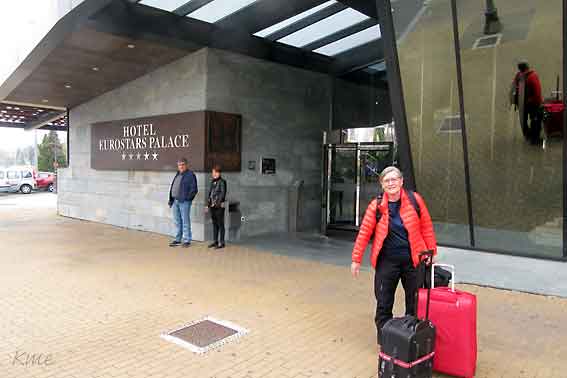
Vi går fra hotel Eurostar Palace

Plaza Oriente og Palacio Real
Visitors to Spain's capital
city are often puzzled to discover that the Plaza de
Oriente is located in the west of Madrid, while its
name suggests an eastern
setting. However, it lies on the east side of
the Palacio Real, and that is why
it is so named.
Juan Bautista Sachetti, who
designed the Palacio Real, had plans to build a
large square in front of the palace in the 18th
century. However, the plans
were not realised until King Joseph I, Napoleon
Bonaparte's brother, ruled
Spain from 1808 to 1813. The unplanned scrabble of
houses then occupying
the eastern side of the palace, some 56 in total,
which included a church and
several convents, as well as a library, were cleared
for the project.
Taking centre stage of Plaza
de Oriente is a huge statue of Felipe IV astride a
horse that was modelled from an art piece by Veláquez.
It stands on a large
pedestal and is indeed a striking sculpture.
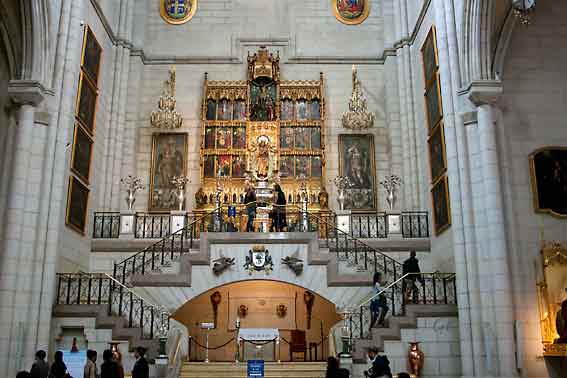
Santa Maria la Real de Almudena
The principle church of the Diocese
of Madrid, the Catedral de Santa María la
Real de la Almudena, is a relatively modern
building, started in 1883 and not
completed until 1993. Remarkable as it may seem, the
delay until such recent
times in the building of a cathedral in the capital
can largely be attributed to
the fact that Madrid was part of the Archdiocese
ofToledo, which was reluctant
to relinquish it.
the capital from Toledo in the creation of the Diocese of Madrid-Alcalá.
Until the current building was completed, the Cathedral was temporarily
housed in the Jesuit College church of San Isidro. Alumeda was finally
consecrated in 1993 by Pope John Paul II, and remains the only Spanish
cathedral to have been consecrated by a Pope.
http://www.gomadrid.com/sights/catedral-almudena.html

Plaza Mayor
The Plaza Mayor is Madrid's main
square. It is located right in the centre of
the city, just a few minutes walk from
the Puerta del Sol.
the arches that skirt the square, this is still a marvellous place to sit out, try
some good Spanish wine, sample some tasty tapas and watch the passers-by.
http://www.gomadrid.com/sights/plaza-mayor.html
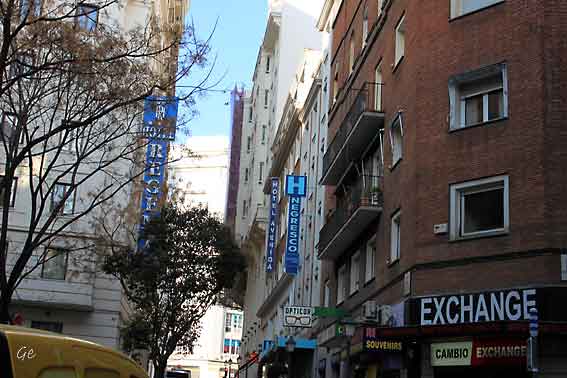
Gata Mesonero Romanos med hotell Avenida som vi bodde på.
Puerta del Sol
This is Madrid's most famous and most central square, located just a short walk
from the Plaza Mayor. Originally it was the site of one of the city's gates, which
faced the east and was adorned with an image of the sun, hence the square's name.
The square is actually almost semi-circular in shape and owes its current form
to the major renovation work carried out between 1854 and 1860.
http://www.gomadrid.com/sights/puerta-del-sol.html
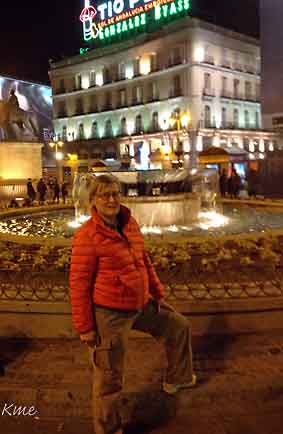 |
 Kveld på Puerta del Sol. Om kvelden kom alle gateselgerne fra. Livlig salg av sko og vesker bl.a. |
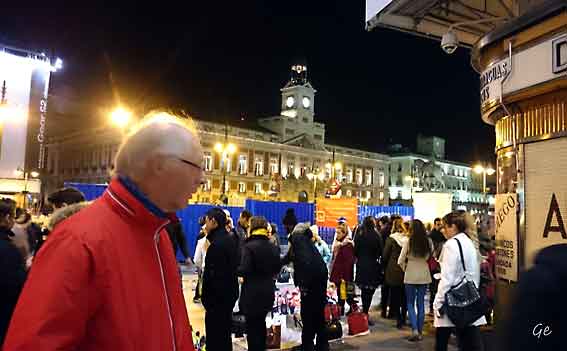
Karl Martin ser på veskeselgerne.
The population of the city is almost 3.2 million with a metropolitan area
population of approximately 6.5 million. It is the third-largest city in the
European Union, after London and Berlin, and its metropolitan area is the
third-largest in the European Union after London andParis. Located in
south-western Europe, the city spans a total of 604.3 km2 (233.3 sq mi).
The city is located on the Manzanares in the centre of both the country and the Community of Madrid (which comprises the city of Madrid, its
conurbation and extended suburbs and villages); this community is bordered
by the autonomous communities of Castile and León and Castile-La Mancha.
As the capital city of Spain, seat of government, and residence of the Spanish monarch, Madrid is also the political, economic and cultural centre of Spain.
The first documented reference of the city originates in Andalusan times as
the Arabic مجريط Majrīṭ (AFI [maʤriːtˁ]), which was retained in Medieval
Spanish as Magerit ([maʤeˈɾit]). A wider number of theories have been
formulated on possible earlier origins.
According to legend, Madrid was founded by Ocno Bianor (son of King
Tyrrhenius of Tuscany and Mantua) and was named "Metragirta" or
"Mantua Carpetana". Others contend that the original name of the city was "Ursaria" ("land of bears" in Latin), because of the many bears that were to be
found in the nearby forests, which, together with the strawberry-tree (Spanish madroño), have been the emblem of the city
from the Middle Ages
https://en.wikipedia.org/wiki/Madrid
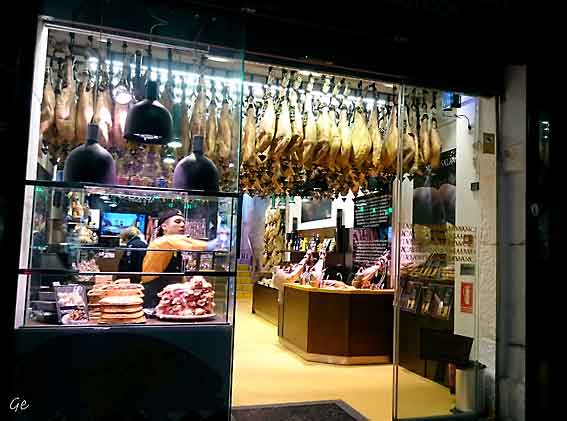
Spekeskinkebutikk
Vi reiste med Madrid City Tour på sightseeing i Madrid.
Første stedet vi gikk av var ved det kongelige slott.
Det var åpent for publikum denne dagen.
The Royal Palace (Palacio Real in Spanish) is not the official residence of his
Majesty the King of Spain, but rather where state ceremonies, official banquets
and other state functions take place. The King lives inZarzuela Palace, which
is just outside of Madrid.
The current Royal Palace, was built on the site of the old Alcázar which was destroyed by fire on Christmas Eve 1734. King Felipe V decided to build a
palace for his Borbon dynasty. The Italian Filippo Juvara was selected to
design the new palace and his plans were to create a grand palace along the
lines of France's Versailles. All construction was vaulted in stone and brick,
not wood, so that any fire could destroy it.
The works were carried out between 1738 and 1755, Carlos III established
his residence there in 1764.
http://www.madridtourist.info/royal_palace.html
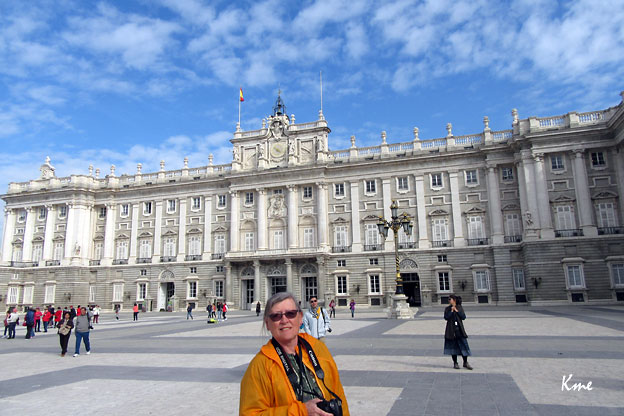
Grete på slottsplassen
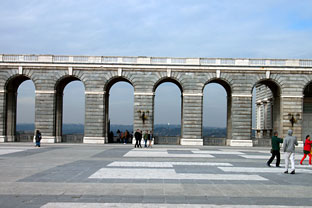 Slottsplassen |
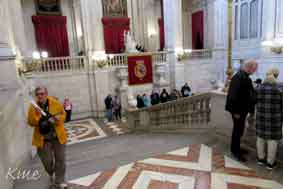 Inne på slottet |
Vi var ikke inne der, men fortsatte til den botaniske hagen.
Det var litt for tidlig på året, ikke så mye blomster enda.
The Royal Botanical Garden of Madrid is an 8-hectare botanical garden
located at Murillo Square, in front of the Prado Museum.
The garden was founded on 1755, by King Ferdinand VI, and installed in
the Orchard of Migas Calientes, near what today is called Puerta de Hierro,
on the banks of the Manzanares River. It contained more than 2,000 plants.
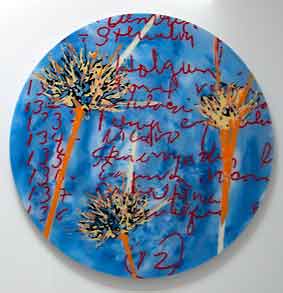 |
 I botanisk hage var det en utstilling av glassprodukter med motiv av forskjellige planter. |
design by architects Francesco Sabatini and Juan Villanueva that organized
the garden into three tiered terraces, arranging plants according to the method
of Linnaeus. Its mission was not only to exhibit plants, but also to teach botany,
promote expeditions for the discovery of new plant species and classify them.
http://www.madridtourist.info/botanical_garden.html
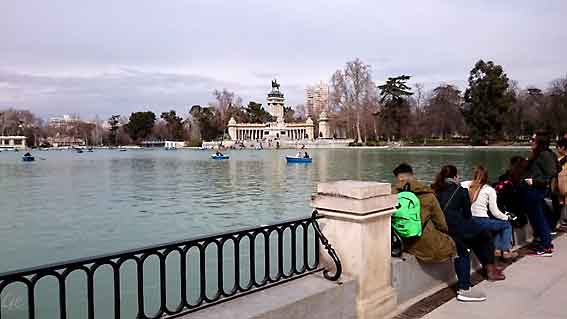
Close to the northern entrance of the park is a large artificial lake, the
Retiro Pond. Next to it is the monument to King Alfonso XII, featuring a
semicircular colonnade and an equestrian statue of the monarch on the top
of a tall central core.
http://www.madridtourist.info/buen_retiro_park.html
The Buen Retiro Park ("Park of the Pleasant Retreat", in english) is the first
biggest park of Madrid city. It has 1.4 km2 (350 acres) at the edge of the
city center. The park belonged to the Spanish Monarchy until the late 19th
century, when it became a public park. It's a magnificent park, filled with
beautiful sculpture and monuments, galleries, a peaceful lake and host to a
variety of events.
History of the park:
The park was born in 1630-1640, when Gaspar de Guzmán, Count-Duke of
Olivares, gave the king Philip IV several tracts of land in the vicinity for
the Court's recreational use.
Philip V (1700–1746) ordered the creation of a parterre, the only French-style
garden in the complex. During the reign of Ferdinand VI, Buen Retiro was
the setting for magnificent Italian operas. Charles III (1759–1788) saw to the
beautification of its perimeter, replacing the old walls with elegant
wrought-iron railings. Juan de Villanueva's Astronomical Observatory was
built during the reign of Charles IV (1788–1808).
http://www.madridtourist.info/buen_retiro_park.html
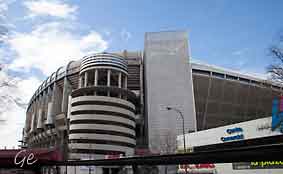 The Santiago Bernabéu Football Stadium is Real Madrid's home ground. It is a UEFA-classified Elite Stadium, awarded the top 5-star status in 2007. |
The
works started on a bare patch of ground on
October 27th, 1944. The inauguration of the stadium, then called Chamartín Stadium (because it's located in Chamartín district), took place on 14 December 1947. Eight years later on January 4th, 1955, Real Madrid changed the name of the stadium to its current name in honor of Santiago Bernabéu, the club's president at the time. http://www.madridtourist.info/bernabeu_stadium.html |

Nytt framkomstmiddel
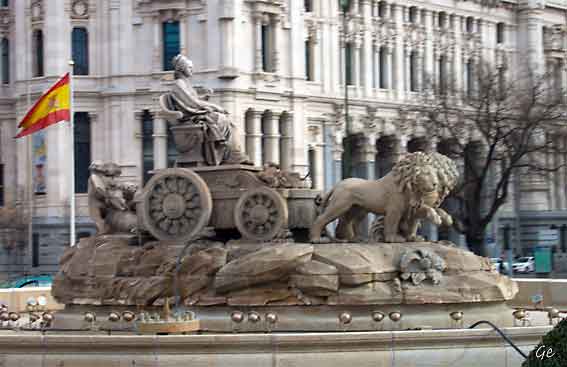
The Cibeles Square is found at the intersection of Alcala Street (which crosses
from west to east), the Paseo de Recoletos (heading north to link up with the
Paseo de la Castellana) and the Paseo del Prado(south, towards the fountain
of Neptune).
This place, one of the most symbolic of the capital, divides the distric
boundaries Centro, Retiro and Salamanca.
In the center of square, is situated the famous fountain of Cibeles, sculpted in
1782, from a design by Ventura Rodríguez. It is a neo-classical complex of
marble sculpture that has become an iconic symbol for the city of Madrid.
The fountain of Cibeles has been adopted by the Football Club Real Madrid,
whose fans use the area to celebrate its triumphs in competitions.
Each of the four corners of the square is dominated by landmark buildings,
built during the late 18th and early 20th centuries.
http://www.madridtourist.info/cibeles_square.html
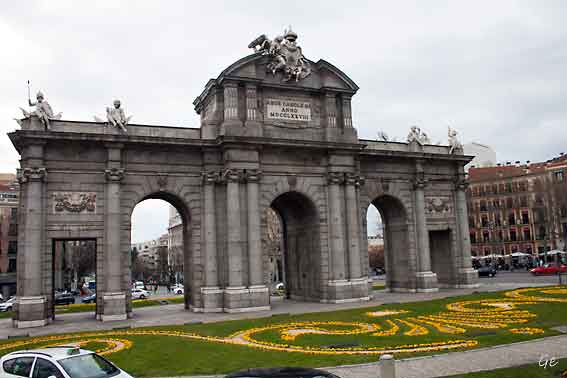
The "Alcalá Gate" (in Spanish, La Puerta de Alcalá) soon became one of
Madrid's symbols and it is one of the most well-known monuments. It is now
classified as a
National Monument.
It is a Neo-classical granite monument in the Plaza de la Independencia square.
It stands near the city center and several meters away from the main entrance
to the Buen Retiro Park. The square is bisected by Alcalá Street, although the
street itself doesn't cross through the monument.
It was designed by Italian architect Francesco Sabatini in 1764 (with the King
Charles III).Charles III ordered it to be built in the city wall, which marked the
eastern boundary.
http://www.madridtourist.info/alcala_gate.html
Mesteparten av dagen var vi i Pradomuseet.
Det ble tid til et besøk i Thyssen-Bornemisza-museet også.
 The Madrid Metro (Spanish: Metro de Madrid) is a metro system serving the city of Madrid, capital of Spain. The system is the 8th longest metro in the world, though Madrid is approximately the fiftieth most populous metropolitan area in the world. |
Its
fast growth in the last 20 years has also put it among the fastest growing networks in the world, rivalling many Asian metros such as the Shanghai Metro, Guangzhou Metro, Beijing Subway or the Delhi Metro. Unlike normal Spanish road and rail traffic, which uses right hand drive, Madrid Metro trains use left-hand running on all lines for historical reasons. The Madrid Metro operates every day from 6 am until 1:30 am. https://en.wikipedia.org/wiki/Madrid_Metro |
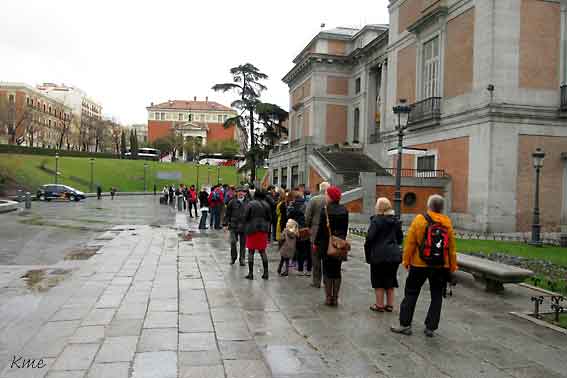
Litt kø var det, men det gikk fort unna.
The building that today houses the Museo Nacional del Prado was
designed by architect Juan de Villanueva in 1785. It was constructed
to house the Natural History Cabinet, by orders of King Charles III.
However, the building's final purpose - as the new Royal Museum of
Paintings and Sculptures - was the decision of the monarch's grandson,
King Ferdinand VII, encouraged by his wife Queen Maria Isabel de Braganza.
The Royal Museum, soon quickly renamed the National
Museum of Paintings and Sculptures and subsequently the Museo
Nacional del Prado, opened to the public for the first time in
November 1819.
https://www.museodelprado.es/en/museum
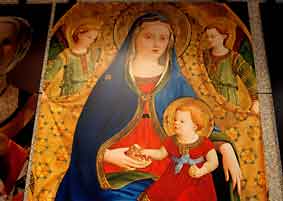 |
 Vi har fotografert en reklameplakat, ikke orginalbildet. |
Created in 1988, the Thyssen-Bornemisza Collection Foundation
pioneered a new formula for the private management of public
assets in Spain, and its efficacy has been apparent ever since the
museum opened its doors in October 1992.
http://www.museothyssen.org/en/thyssen/acerca_del_museo
 |
 |
I butikken på Thyssen-Bornemisza solgte de sykkelvesker
med motiv fra kjente malere.
Det hadde vært gøy å kjøre rundt med SKRIK-sykkelveske,
men prisen var for høy.

Dette skulle ha vært hjemreisedagen. Men sånn ble det likevel ikke.
Flyet vårt skulle gå om ettermiddagen, så vi hadde ganske god tid.
Derfor tok vi en tur ned til Puerta del Sol der vi kom over et historisk tablå,
opprørske bønder mot øvrigheten.
Etterpå tok vi taxi ut til flyplassen.


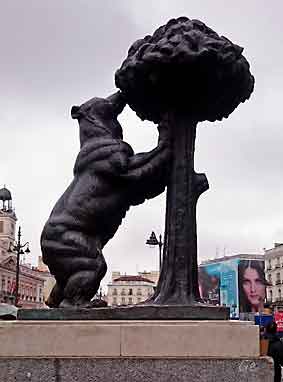 The Puerta del Sol is also the location of the most famous symbol of Madrid: a 20 ton statue of a bear eating fruits from a tree. |
 The official name of the statue is 'El Oso y El Madroño'. According to legend the original name of the city was "Ursaria" ("land of bears" in Latin), due to the high number of these animals that were found in the adjacent forests, which, together with the arbutus ("madroño" in Spanish), have been the emblem or symbol (The Bear and the Strawberry Tree) of the city from the Middle Ages. http://www.madridtourist.info/puerta_del_sol.html |
At Madrid Marriott Auditorium Hotel & Conference Center, located really
close to the Adolfo Suarez Madrid – Barajas Airport and Ifema Fair, you will
find the perfect balance between Business and Travel experience.
A place with large and different spaces to celebrate events and conferences thanks to the 56 pillar-free and the more than 15.000sq as well as the Auditorium for up
to 2000 people. Everything accompanied by an innovation and style necessaries
to enjoy the unforgettable experience of travel. Besides the hotel has been
renovated all the 869 rooms as well as the food & beverage areas with the Champion´s Bar, Greatroom, Atrium Bar and a la carte restaurant called Kalma.
The new largest Marriott Hotel in Europe is a place where you will celebrate successfully any kind of event thanks to the magic and inspiration that all spaces transmit, accessible for all kind of exhibition materials, included vehicles as well
as parking service with 1000 parking places and the free Wifi connection,
shuttle, fitness center and indoor/outdoor swimming pool.
http://blog.hotelauditoriummadrid.com/en/home/
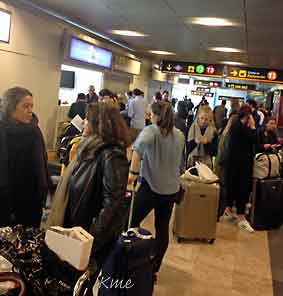 Ved den oppgitte tiden for ombordstigning kom meldingen om at flyvningen til Oslo var kansellert på grun av flygelederstreiken i Frankrike |
 Vi måtte hente bagasjen vår, og så ble vi ble losa til en buss som tok oss til hotel Auditorium. |
Industrial action
being taken by French air traffic controllers is
already having a
knock-on effect in the UK as flights out of British
airports were cancelled on Sunday.
The strike is planned for the next three days and is
taking place against a cap on
recruitment and lack of investment in systems used
by air traffic controllers.
scheduled to take off from UK airports. Not only flights heading into France are being
affected but other that were to fly through French airspace are being rerouted too.
http://www.ibtimes.co.uk/flights-delayed-cancelled-french-air-traffic-controllers-start-3-day-strike-1550616
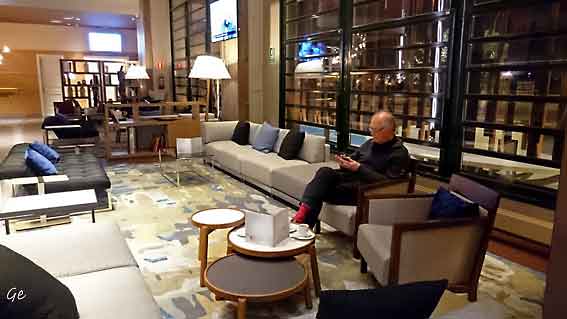
Hotel Auditorium
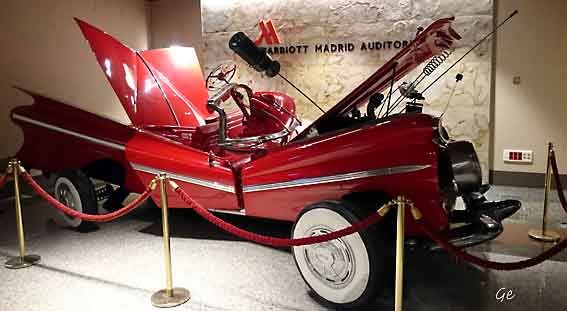
Hotel Auditorium
Det var påskeuka, og fulle fly.
Til slutt fikk vi billetter med Air Brüssel,
via Brüssel til Oslo tirsdag 22. mars.
Mandagen tok vi en tur inn til Madrid.
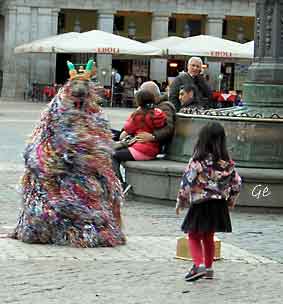 |
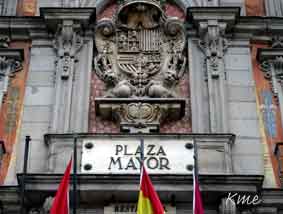 |
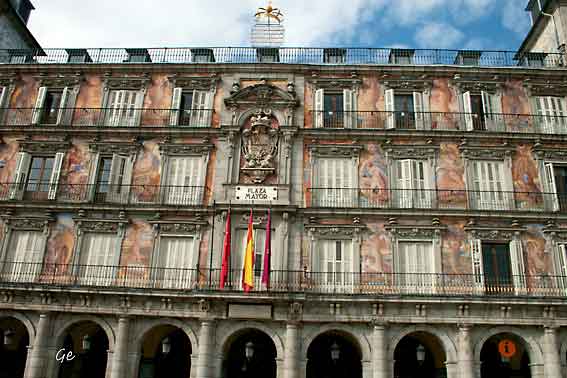
The present building of the Casa de la Panadería stands at number 27 on
the north side of Madrid's Plaza Mayor, just behind the central statue of
Felipe III. The original building was a wooden construction designed by Juan
Gomez de Mora and completed in 1619.
| It was destroyed by fire in
1670 and was rebuilt by Thomas Roman. Claudio Coello and Jose Jimenez Donoso were responsible for the façade frescoes and interior decoration. In 1790 there was another fire in the plaza. Juan de Villanueva was then responsible for the reconstruction of the building. |
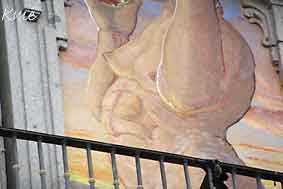 |
refurbishments since, notably in 1880 under the direction of Joaquin Maria de la
Vega.
In 1914 Enrique Guijo was commissioned to do decorative paintings on the
façade. By 1988 the decoration had deteriorated so much that the Madrid
City Council held a competition to find an artist to restore the façade.
A number of artists were invited to compete including Sigfrido
Begué Martin, Carlos Franco and Guillermo Pérez Villalta.
Carlos Franco was chosen for the task and the work was completed in 1992.
http://www.gomadrid.com/sights/casa-de-la-panaderia.html
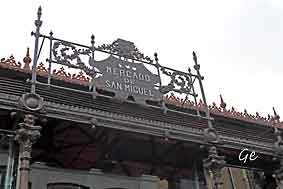 |
The Mercado de San Miguel More than 100 years have gone by since the Mercado de San Miguel opened its doors as a wholesale food market. Today, this historical building stands out as one of the world’s main gastronomic markets. It allows visitors to experience the essence and most significant flavors of every corner of Spain. |
https://mercadodesanmiguel.es/

Mercado de San Miguel
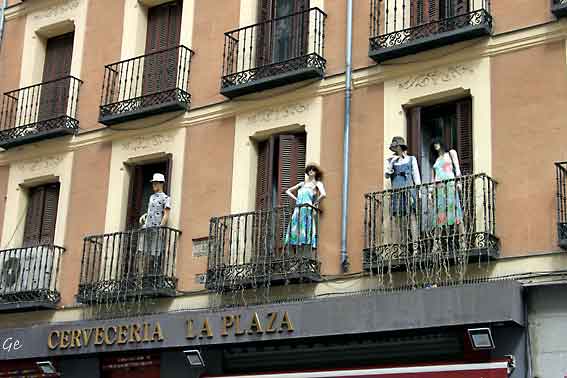
Hus på Plaza de San Miguel
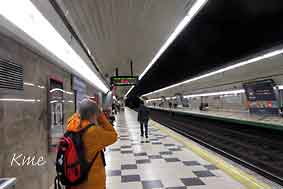 Grete på Principe de Vergara metrostasjon |
Vi hadde
tenkt å reise tilbake til hotellet med offentlig
transport. Det vil si to strekninger med metro og så det siste stykke med buss. Vi fant bussterminalen. Den var stor, og akkurat da kom det en voldsom regnbyge,så vi smatt inn i en taxi og kjørte til hotellet. |
Vi skulle reist hjem, men kom ikke hjem nå heller pga dette:
A series of deadly explosions
rocked Brussels on Tuesday, targeting
theBelgian capital's main airport and metro
system.
Belgian officials said the bombings
at Zaventem airport and the
Maelbeek metro station killed at least 34 people and
injured more
than 230, according to reports. Officials raised the
city's terror
threat level and shut down public transit after the
blasts.
moment for the country.
http://www.cnbc.com/2016/03/22/several-injured-after-explosions-at-brussels-airport-report.html

Kø for ombooking. Og intervju med en fra Brüssel Airlines.
Vi fikk billetter til samme rute på torsdag.
Da skulle flyplassen i Brüssel være åpen igjen mente de.
Toledo, en gang Spanias hovedstad, ligger bare ca 1/2 time med tog
fra Madrid, så vi tok en tur dit.
Toledo var tydeligvis et populært reisemål. Det gikk tog dit hver time.
Det var ikke plass til oss på de to første, så det ble lenge å vente på
stasjonen i Madrid.
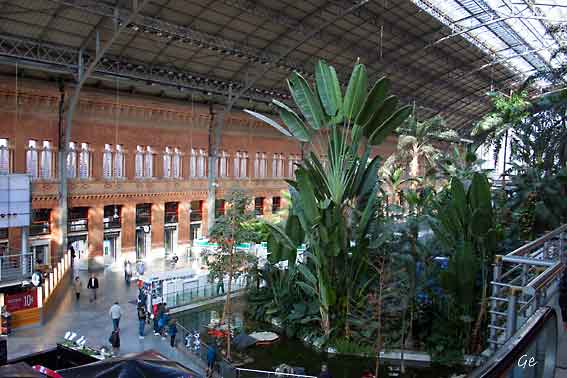
Puerta de Atocha) is the largest railway station in Madrid. It is the primary
station serving commuter trains (Cercanías), intercity and regional trains
from the south, and the AVE high speed
trains from Barcelona (Catalonia), Zaragoza (Aragon), Seville (Andalusia) and
Valencia (Levante Region). These train services are run by the Spanish
national rail company, Renfe.
https://en.wikipedia.org/wiki/Madrid_Atocha_railway_station

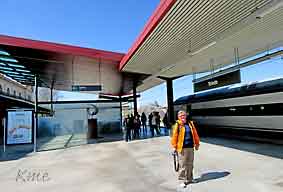 |
The Toledo railway
station The railway reached Toledo |
was of functional design. The central section is flanked by two side naves,
one of which is adjacent to the clock tower, which imitates the style of
Toledo church towers.
The station has been declared a Property of Cultural Interest and classified as
a monument. It was restored in the twenty-first century in connection with the
inauguration of a high-speed service to Madrid in 2005.
https://en.wikipedia.org/wiki/Toledo_railway_station
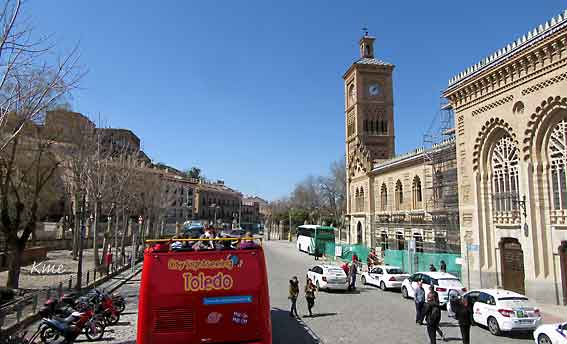
Toledo jernbanestasjon

Elva Tajo ved Toledo
Ancient Greek: Τάγος Tagos) is the longest river on the Iberian Peninsula.
It is 1,038 km (645 mi) long, 716 km (445 mi) in Spain, 47 km (29 mi)
along the border between Portugal and Spain and 275 km (171 mi) in
Portugal, where it empties into the Atlantic Ocean near Lisbon.
It drains an area of 80,100 square kilometers (30,927 sq mi)(the second
largest in the Iberian peninsula after the Douro). The Tagus is highly utilized
for most of its course. Several dams and diversions supply drinking water to
most of central Spain, including Madrid, and Portugal, while dozens of
hydroelectric stations create power. Between dams it follows a very constricted
course, but after Almourol it enters a vast alluvial valley prone to flooding.
At its mouth is a large estuary on which the port city of Lisbon is situated.
The source of the Tagus is the Fuente de García, in the Frías de Albarracín
municipal term, Montes Universales, Sistema Ibérico, Sierra de Albarracín
Comarca. All its major tributaries enter the Tagus from the right (north) bank.
The main cities it passes through are Aranjuez, Toledo, Talavera de la Reina and
Alcántara in Spain, and Abrantes, Santarém, Almada and Lisbon in Portugal.
https://en.wikipedia.org/wiki/Tagus
Toledo (Spanish: [toˈleðo]) is a municipality located in central Spain, 70 km
south of Madrid. It is the capital of the province of Toledo and the autonomous
community of Castile–La Mancha. It was declared a World Heritage Site by
UNESCO in 1986 for its extensive cultural and monumental heritage and
historical co-existence of Christian, Muslim and Jewish cultures.
Toledo is known as the "Imperial City" for having been the main venue of the
court of Charles I, and as the "City of the Three Cultures", having been
influenced by a historical co-existence of Christians, Muslims andJews.
In 1085, the city fell to Alfonso VI of Castile as the first major city in the Christian Reconquista.
Toledo has a history in the production of bladed weapons, which are now
popular souvenirs of the city. People who were born or have lived in Toledo include Brunhilda of Austrasia, Al-Zarqali, Garcilaso de la Vega, Eleanor of Toledo, Alfonso X and El Greco. It was also the place of important historic
events such as theVisigothic Councils of Toledo. As of 2015, the city has a
opulation of 83,226[1] and an area of 232.1 km2 (89.6 sq mi).
https://en.wikipedia.org/wiki/Toledo,_Spain
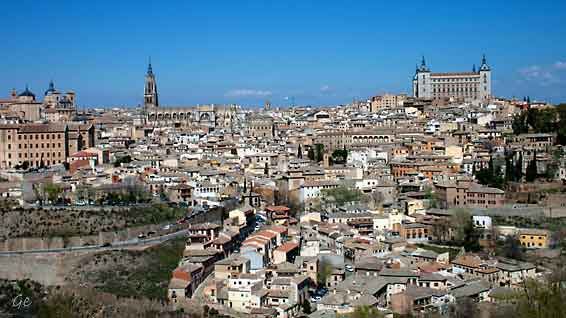
Toledo med Katedralen og Alcazar
PUERTA NUEVA
DE BISAGRA
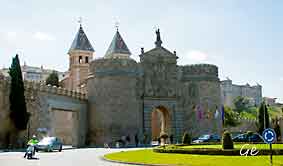 |
The Puerta
de Bisagra (originally Bab
al-Saqra, also called Puerta de Alfonso VI) is a city gate of Toledo, Spain. The structure was constructed in the 10th century, in the time of the Moorish Taifa of Toledo in Islamic Al-Andalus. It is also called 'Bisagra Antigua' to distinguish it |
from
the Puerta de Bisagra Nueva which
was built in 1559. The gate was
the main entrance to the city and dates from the
Moorish period.
Puerta
de Bisagra - Wikipedia (19.
desember 2022)
to the right: Puerta del Sol is a city gate of Toledo, Spain, built in the late 14th
century by the Knights Hospitaller.
The medallion above the arch of the gate depicts the ordination of the Visigothic
Ildephonsus, Toledo's patron saint. The name of the gate comes from the sun and
the moon that were once painted on either side of this medallion.
https://en.wikipedia.org/wiki/Puerta_del_Sol,_Toledo
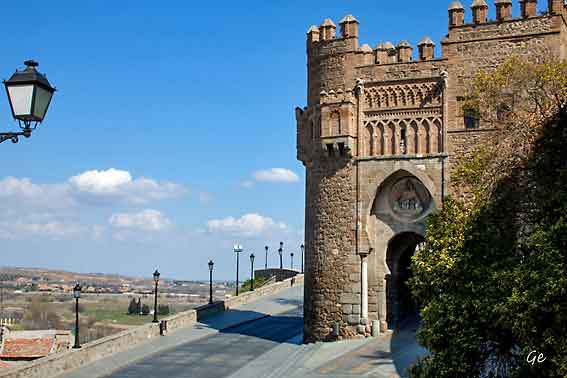
Puerta del Sol
| Lunsj
innenfor murene. Vi spiste bacalao. |
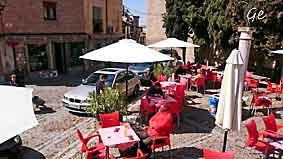 |
city is surrounded by the River Tajo on three sides and two medieval walls
on the fourth side. The old city is relatively small and can be crossed in
45 minutes, so you are never too far from the center. When you want to
head back, just head uphill and you are virtually guaranteed to end up at
the main plaza, Plaza de Zocodover. There is a "Land Train" operating from
the centre of the town. A good way to look around, particularly if you can't
walk too far.
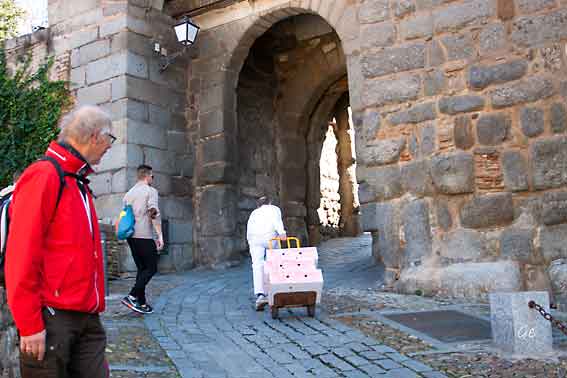
 (Toledo, 1501? - Niza, 1536) Poeta renacentista español. Perteneciente a una noble familia castellana, Garcilaso de la Vega participó ya desde muy joven en las intrigas políticas de Castilla. http://www.biografiasyvidas.com/biografia/g/ garcilaso.htm |
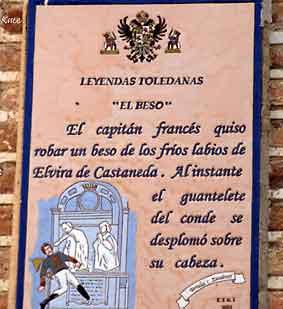 Etter maskinoversttelse: Den franske kapteinen ønsket å stjele et kyss fra leppene til Elvira de Castaneda. Øyeblikkelig falt hansken til jarlen over hodet hans. |
CATEDRAL
|
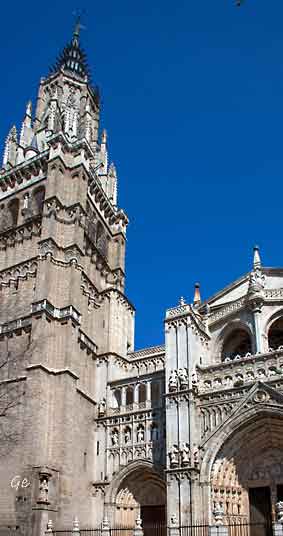 |
been a church in the sixth century during the reign of the Visigoth King Recaredo.
King San Fernando and the archbishop began building the new church in 1226.
The fifteen chapels of the ambulatory were subsequently completed. In the year
1300 the transept nave was completed, although work continued on the church
for the next two centuries. The church has five naves and measures 120 metres
long and 59 metres wide. The roof is supported by 88 columns. The
polychromatic stained glass windows date back to the fourteenth, fifteenth and sixteenth
centuries. The altarpiece in the main chapel has five sections, depicting scenes
from the New Testament, along with life-sized polychromatic sculptures made
of gilded wood.
It was commissioned by Cardinal Cisneros and made between 1497 and 1504.
The fifteenth century Santiago Chapel, has a flamboyant Gothic style and houses
the sarcophagi of Alvaro de Luna and his wife Juana de Pimentel.
Christendom.
The grille that surrounds the choir is by Domingo de Cespedes.
The lower choir stalls were begun in the fifteenth century
depicting scenes of the surrender of cities and fortresses up
until the conquest of Granada. The upper choir stalls are made
up of 72 ceremonial chairs that were designed by Alonso de
Berruguete and Felipe Vigarni, in the sixteenth century.
The so called 'Ochavo' is a large sumptuous room from the
sixteenth century dedicated to the martyrs and witnesses of Christ,
housing invaluable works of art, such as the reliquary of San Luis,
a bust of St. John the Baptist and the cross of Cardinal Mendoza.
It is possible to view works by Lucas Jordan and el Greco in the
main sacristy.
http://www.spain.info/en/que-quieres/arte/monumentos/toledo/catedral_de_toledo.html
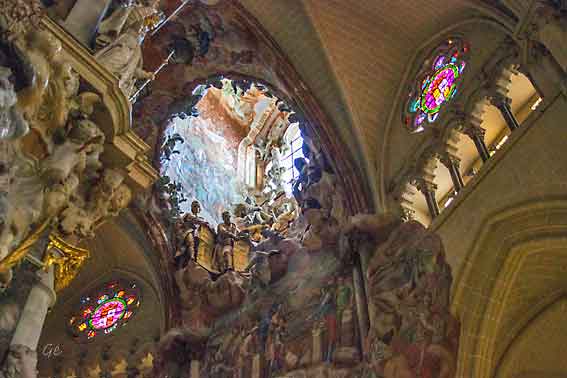

was then part of the Republic of Venice. In his mid-twenties, he traveled to
Venice and studied under Titian, who was the most renowned painter of his
day. Around age 35, he moved to Toledo, Spain, where he lived and worked for
the rest of his life, producing his best-known paintings. His works from this
period are seen as precursors of both Expressionism and Cubism. He is
remembered chiefly for his elongated, tortured figures, often religious in
nature, the style of which baffled his contemporaries but helped establish his reputation in the years to come.
In Toledo, El Greco met Diego de Castilla, the dean of the Toledo Cathedral,
who commissioned El Greco to paint a group of works for the altar of the
church of Santo Domingo el Antiguo (such as The Trinity and The Assumption
of the Virgin, both 1579). Castilla also facilitated the commission of The
Disrobing of Christ (1579), and these paintings would become some of
El Greco’s most accomplished masterworks. (Unfortunately, the price
El Greco demanded for The Disrobing of Christ led to a dispute, and he
never received another comparable commission from Castilla again.)
http://www.biography.com/people/el-greco-9319123#finding-a-foothold-toledo-spain

Malerier av El Greco (i Katedralen i Toledo)
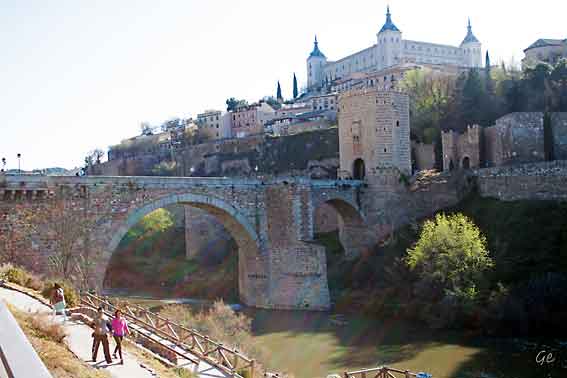
Alcázar fortress in Toledo
It is today the site of the city's Army Museum. Its construction dates from
Roman times. During the reigns of Alfonso VI and Alfonso X 'the Wise' it was
rebuilt and became the first example of a square fortress with towers on the
corners.
It was once again rebuilt under Emperor Charles V, on this occasion by the
architect Alonso de Covarrubias. The façades are Renaissance in style, and it
has towers and crenellated defences according to a preliminary design by
Alonso de Covarrubias, subsequently completed by Juan de Herrera. After the
last reconstruction it became the site of the Army offices and museum.
Alcázar fortress in Toledo in Toledo | spain.info in english (27. januar 2022)
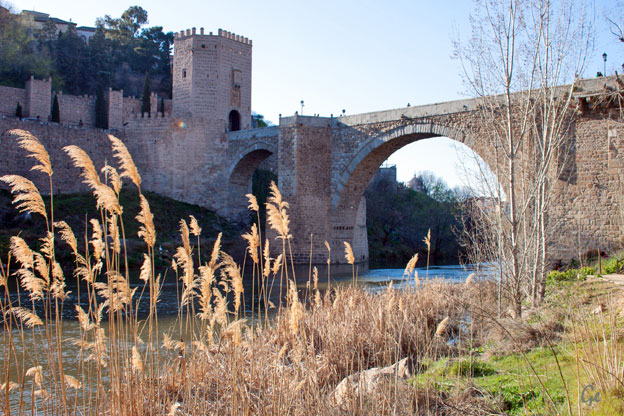
Puente de Alcantara
The Puente de Alcántara is a Roman arch bridge in Toledo, Spain, spanning the River Tagus. The word Alcántara comes from Arabic القنطرة (al-qanţarah),
which means "arch".
Located at the foot of the Castillo de San Servando, it was built by the Romans
after they founded the city. In the Middle Ages it was one of the few entrances
for pilgrims into the city.
It currently has two arches. There is evidence of its construction in Roman
times, at the founding of Toletum. It was damaged and rebuilt in the
10th century, at which time a third arch disappeared, reduced to a gate with a horseshoe arch. It was one of the only bridges that gave access to the city and
in the Middle Ages it was the obligatory entry for all pilgrims.
During the reign of Alfonso X of Castile it suffered serious damage and was
rebuilt. The western tower belongs to this period, later decorated under the
reign of the Catholic Monarchs, whose arms decorate its walls. The fruit of the pomegranate (the emblem of Granada) is missing from them, because the Reconquista had not finished at that time.
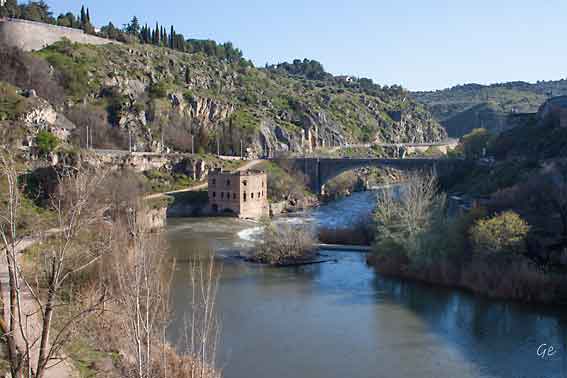
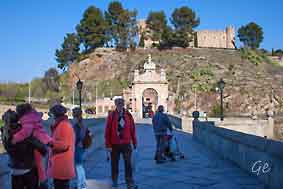 |
Karl Martin
på Puente de Alcantara |
of its ruinous state.
It was declared a national cultural monument in 1921.
The bridge should not be confused with either the Alcántara Bridge in
Alcántara or the Alconétar Bridge in the Extremadura region, both Roman bridges
which cross the River Tagus further downstream.
Puente de Alcántara - Wikipedia (19. desember 2022)
Da regnet de med at flyplassen skulle være åpen igjen. Dette var nok litt
optimistisk.Flyplassen ble ikke åpnet før 1.5
Vi fikk ordnet nye billetter med KLM til København via Amsterdam,
og fra København til videre til Oslo med SAS
Det hadde vært en fin Spaniatur, men likevel;
det var godt at vi endelig kom oss ombord på et fly på vei hjem.
Alt gikk etter ruta. Men det ble likevel en lang reise på grunn av lang
ventetid på Kastrup, København. Heldigvis rakk vi flytoget fra Gardemoen
før de sluttet å gå for natta. Men det siste stykke hjem (Asker-Slemmestad)
måtte vi ta med taxi. Siste buss hadde gått.
Men alt i alt, til tross for forsinkelser, det var en fin tur!
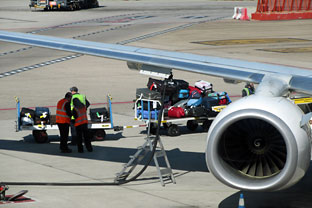
Bilder: Karl Martin og Grete


